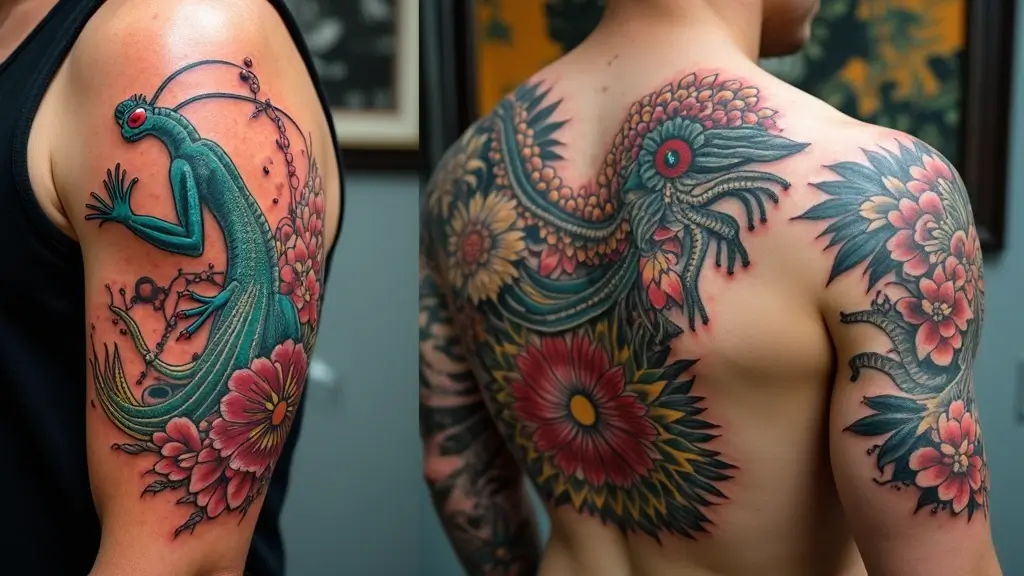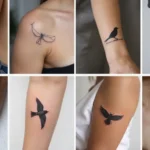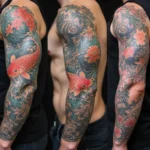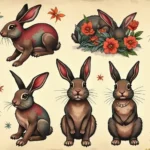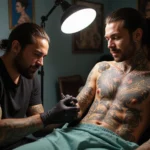30 Traditional Praying Mantis Tattoo Ideas You’ll Love grabbed my attention because I crave tattoos that feel timeless and calm. This post is for anyone who loves clean lines, classic motifs, and art you can wear proudly. I pulled together 30 praying mantis tattoo ideas that are bold, refined, and ready to spark your next ink. Here is why this matters: traditional mantis designs stay sharp for years and pair well with other pieces you might add later.
Praying mantis designs carry patience, focus, and quiet strength. In traditional style you see bold outlines, solid fills, and clean shapes that age well. These designs work from tiny wrist pieces to larger back pieces and fit many spots. From forearms to shoulders, calves to chests, a mantis can adapt to your body and your goals.
If you want ink that looks symbolic and stylish, this is for you. If you care about meaning like patience, transformation, or mindfulness, a mantis tattoo can carry that message. These ideas aim to help you find a design that matches your vibe and your life.
Here is what you’ll get from this list. Different scales, placements, and moods, all rooted in the traditional vibe. I’ll share notes you can take to talk with your artist about size, placement, and how the ink will heal. Think about line weight, shading, and whether you want color or a bold black and gray piece so the ink stays strong over time.
Use these ideas as starting points. Bring sketches to your artist and ask for tweaks. Mix elements from several ideas to tailor a piece to your story. Try placing a tiny mantis on a finger or a larger one on the shoulder to feel the vibe before you commit.
Not every idea fits every body. Be honest about what hurts or what you want to hide or show. Work with a skilled artist who loves traditional ink. Save your favorites, bring them to your studio, and start a real conversation about what fits you best.
1. Classic Green Mantis
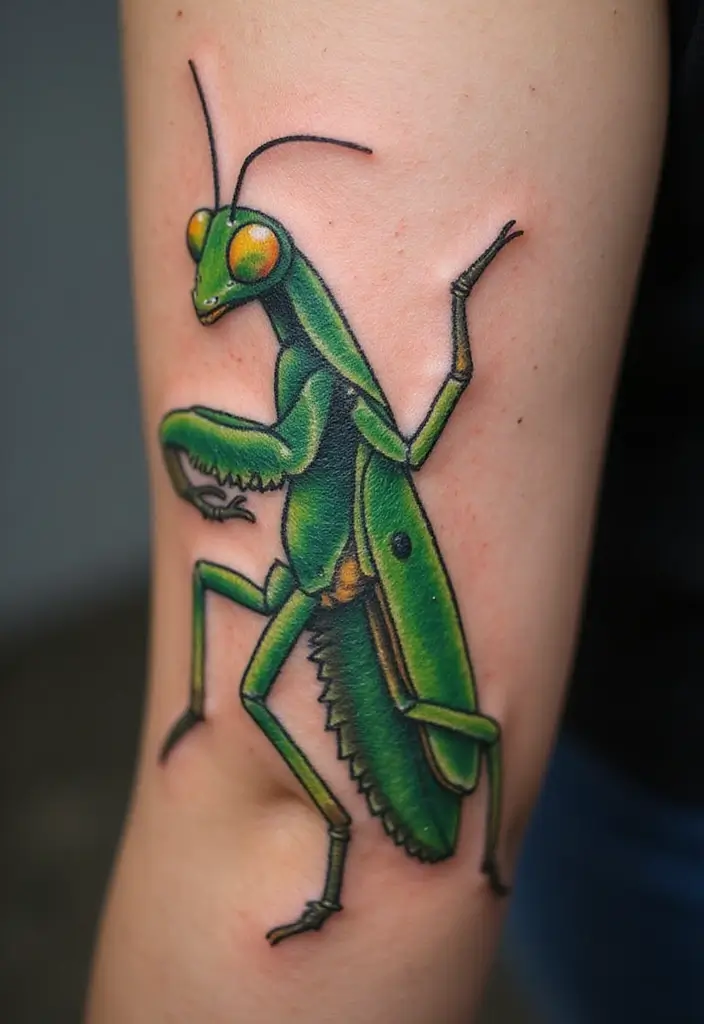
Looking for a tattoo that feels calm, natural, and easy to wear? The Classic Green Mantis delivers. This design shows the praying mantis in a simple, lifelike pose. Clean line work keeps it crisp, while layered greens give the insect its life. You get a piece that hints at nature without shouting.
Here is why it works: the mantis represents balance and focus. Its quiet form invites you to slow down and stay grounded.
Placement is practical too. Try the forearm for easy visibility, or the calf for a more discreet look. It fits most sizes.
Expect a soft, smooth finish that sits close to your skin. Your artist will blend greens with gentle shading for depth.
Tips:
– Size: Start small if you’re new, or go larger for more detail.
– Color: Stick to greens: forest, olive, and a splash of lime, plus soft shading for depth.
– Details: Keep line work clean; add a few floral accents to echo nature.
– Finish: Plain black outline with subtle color ages better; bold greens stay vivid longer.
Next steps: bring photos of mantis poses, talk with your artist about spacing and shading, and plan a simple design you can wear on your forearm or calf. It scales well on spots.
2. Mantis with Flowers
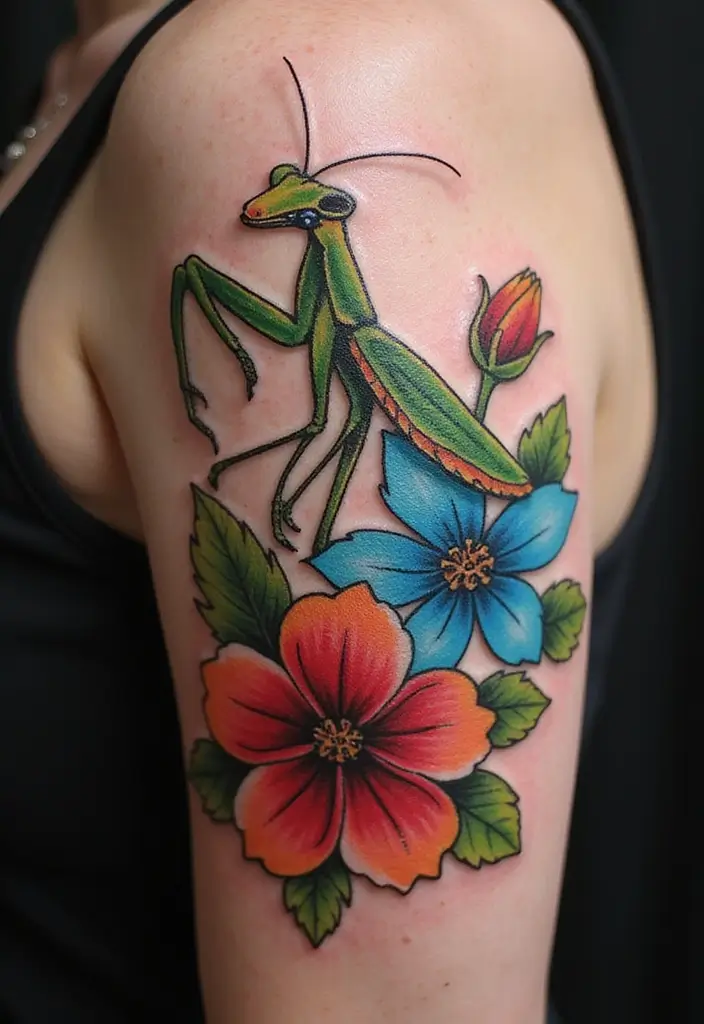
If you want a tattoo that blends nature with quiet strength, a praying mantis among flowers can give you that feel. The mantis stays sharp, while the blooms soften the scene. It reads like a small story you wear.
Flowers add meaning. They stand for growth, love, and simple beauty. The mantis adds focus and patience. Together, they deepen the message you carry on your skin.
Styling Tips:
– Choose flowers that speak to you. Roses for love, daisies for innocence, lotus for enlightenment.
– Pick a color plan that fits your vibe. Bold reds and greens work well, or keep things soft with pinks and purples.
– Decide on placement. A sleeve lets the mantis wind through the blooms, while an upper back design acts as a striking centerpiece.
– Think about line and shade. Fine lines with gentle color can feel delicate, while strong outlines give drama.
Next steps:
– Bring reference photos of mantis and blooms you like.
– Talk with your artist about flow with your body, scale, and what hides or shows with movement.
– Plan for aging and aftercare to keep the colors true.
| Tattoo Design | Description | Placement Suggestions | Color Options | Style Tips |
|---|---|---|---|---|
| Classic Green Mantis | Simple, lifelike pose with layered greens. | Forearm, calf. | Forest, olive, lime. | Start small or go larger for detail. |
| Mantis with Flowers | Blends nature with quiet strength, flowers add meaning. | Sleeve, upper back. | Bold reds, greens, soft pinks, purples. | Choose flowers that resonate with you. |
| Watercolor Mantis | Soft washes and bold splashes for a vibrant look. | Wrist, forearm, shoulder. | Blues, greens, purples. | Ask for clean lines and light shading. |
| Black and Grey Mantis | Timeless design relying on shading and line work. | Forearm, upper arm, inner forearm. | N/A | Keep line work thin for clarity. |
| Tribal Mantis | Bold, minimal look with thick lines and geometric shapes. | Shoulder, upper arm, chest, back. | N/A | Mix in curved lines for balance. |
| Geometric Mantis | Modern design using triangles and clean shapes. | Upper back, outer thigh. | N/A | Request crisp line weights and avoid heavy shading. |
3. Watercolor Mantis
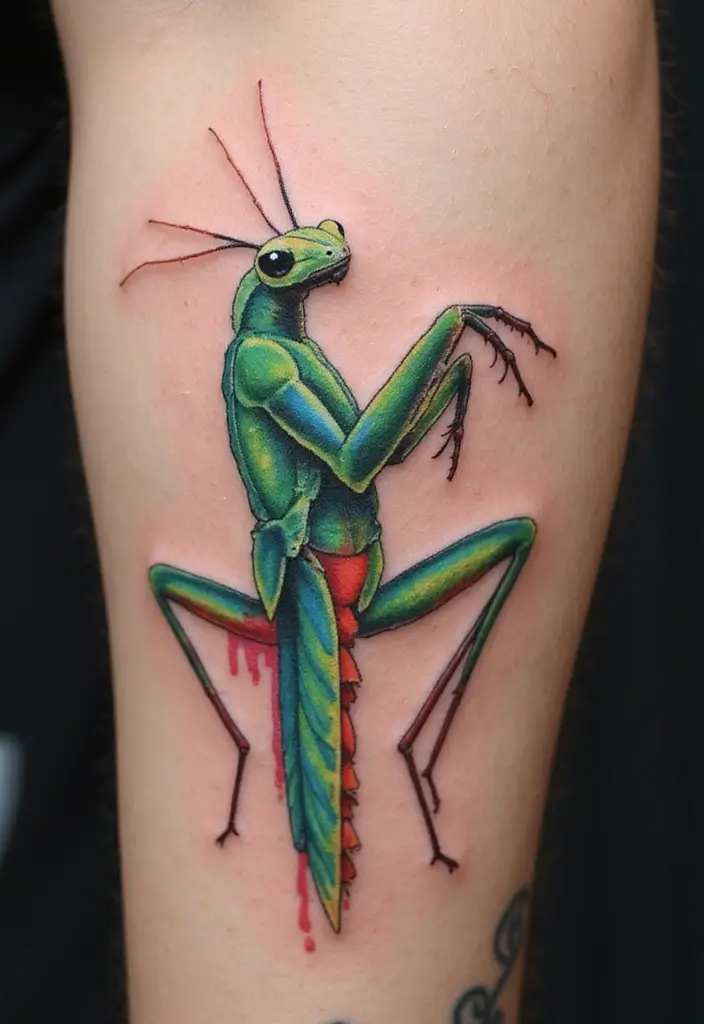
Watercolor Mantis
Watercolor tattoos give a painter’s touch on skin. If you want color that feels alive, this is your pick. Soft washes mix with bold splashes to make the mantis look like it could jump at any moment.
Why choose watercolor?
It adds an art vibe to a classic insect design. The result is a unique piece that shines on the wrist or shoulder. Keep lines clean and shading light so the color can breathe.
Here is why blues, greens, and purples can suit a mantis. Blues echo rain, greens trace leaf homes, purples add a dreamy touch. Or choose hues that fit your style so the tattoo is truly yours. For a subtler piece, pick softer tones. For a bold statement, layer richer pigments.
Placement tips
– Visible areas like the wrist, forearm, or shoulder show off the wash technique.
– Ask your artist to add a thin black outline in key spots to keep shapes clear as color ages.
Next steps
– Talk about color tests and stencil previews.
– Limit sun exposure and follow aftercare to keep colors bright.
– Bring a design photo to your appointment to align expectations.
With the right artist you get a wearable painting that stays true to your vibe.
4. Black and Grey Mantis
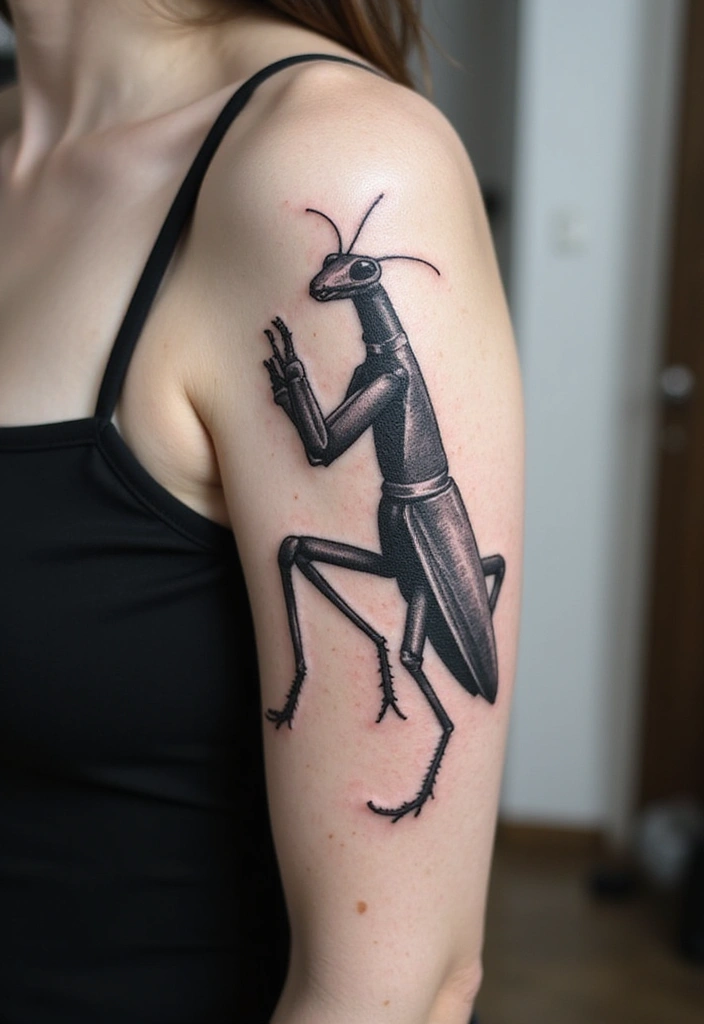
If you want a clean, timeless tattoo, the black and grey mantis fits. It relies on shading and line work, not color, to stay sharp for years. Here is why this style works: it stays calm, precise, and easy to wear.
The look comes from shading. Black ink builds depth, while soft gray tones give the mantis form without shouting. The result is a subtle three dimensional feel that stays neat with age. This design uses fine lines and careful shadows to show the mantis with light contrast.
This style suits both men and women. A simple, crisp outline with light shading keeps it versatile. It ages well on many body parts because it remains readable, even as skin changes. Many people choose it for its clean look.
Placement Ideas:
– Forearm or upper arm lets you show the art.
– For a quieter look, try the inner forearm.
Texture and details: Add geometric shapes around the insect or soft floral hints to keep it elegant. Keep the line work thin for the legs and eyes so it reads clearly.
Care tips: Let the skin heal fully, wash gently, and avoid strong sun early on.
Next steps: decide on size and placement that fit your wardrobe.
5. Tribal Mantis
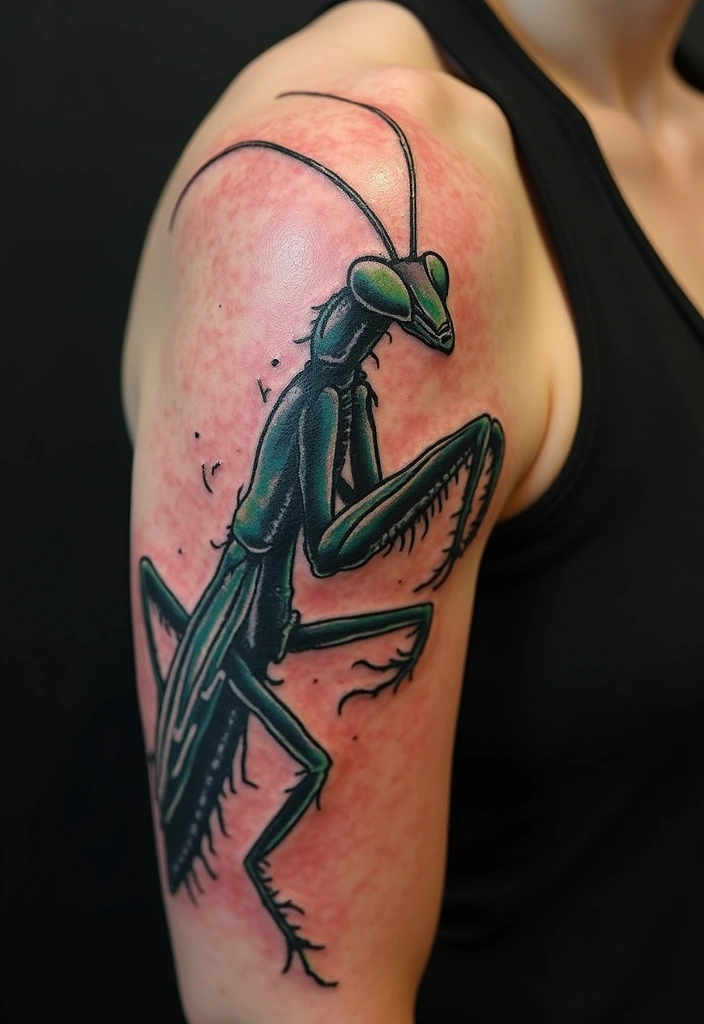
The tribal mantis tattoo brings a bold, minimal look to your skin. It uses thick black lines and geometric shapes to turn the mantis into a powerful symbol. You get a piece that feels ancient and modern at the same time.
What this design says: strength, courage, and discipline. Tribal art often carries layered meanings from different cultures. You can choose to honor a tradition or simply enjoy the striking silhouette.
Design tips: Use sharp angles to suggest speed and precision. Mix in curved lines to hint at the mantis’s smooth moves. Try combining tribal patterns from a few cultures for a unique twist that fits you. Keep the balance between dense line work and negative space so the image breathes.
Where it works best: the shoulder for a broad, visible display; the upper arm or chest for a bold statement; the back for a larger, detailed piece that can wrap with your muscles.
Next steps: talk with a tattoo artist about line width and spacing. Decide how much of the body you want the design to cover. Bring examples of tribal patterns you like so the artist can blend them into one custom piece.
Make sure it feels right.
A tribal mantis tattoo isn’t just a design; it’s a powerful statement of strength and discipline. Embrace the bold, minimal look and let your skin tell a story of courage that feels both ancient and modern!
6. Geometric Mantis
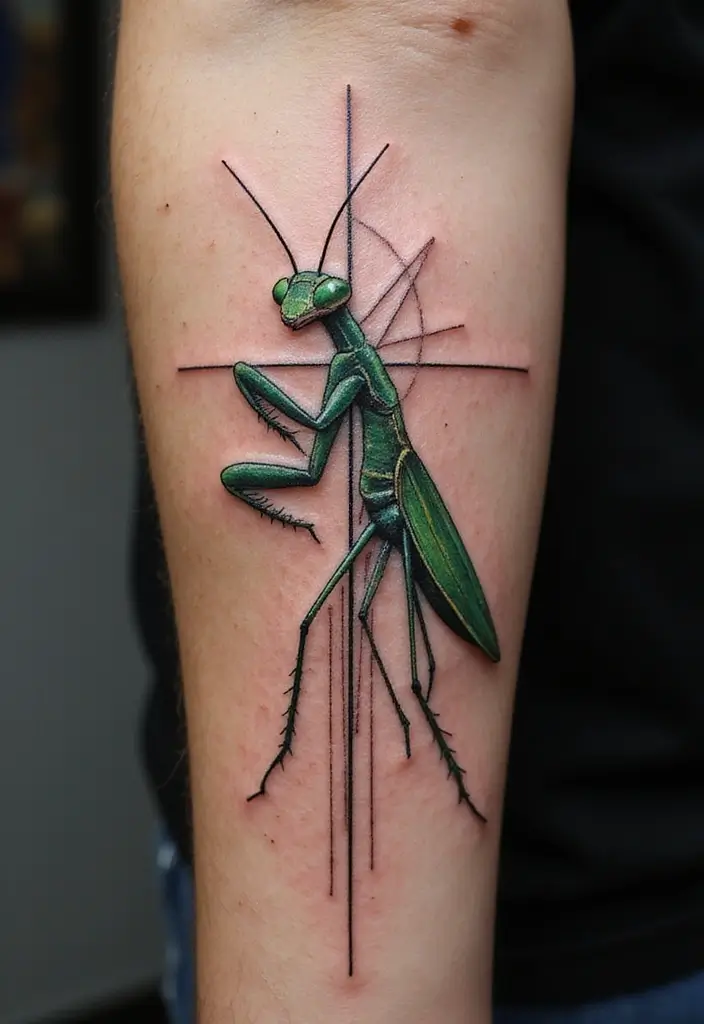
If you want a tattoo that feels modern but still true to nature, the geometric mantis fits perfectly. The geometric praying mantis uses triangles, lines, and clean shapes to form the insect. It preserves the mantis’s pose and its quiet energy while giving it a sharp, graphic look. The result reads strong on skin and ages gracefully, so you can still see it years from now.
Geometric designs hinge on balance. Straight edges meet curved lines, creating calm symmetry. This style suits you if you like simple shapes with a clear idea behind them. It pairs well with bold, clean lines and little shading for a timeless feel.
Placement Suggestions:
– Upper back
– Outer thigh
To make the design pop, add line work that follows the mantis’s movement. Use varying line weights—from bold outlines to fine inner lines. Let some lines fade into negative space to suggest motion and breath. This keeps the tattoo lively without crowding the shapes.
Here is how to plan and talk with your artist. Gather 3–5 reference images of geometric mantis tattoos and clean line work. Decide on size and placement so the shapes breathe on your body. Ask for crisp, even line weights and sharp corners; avoid heavy shading that hides edges. Request light shading only where you want depth, not to blur the geometry.
With these steps you can get a smooth, modern tattoo that still feels true to the mantis.
7. Realistic Mantis
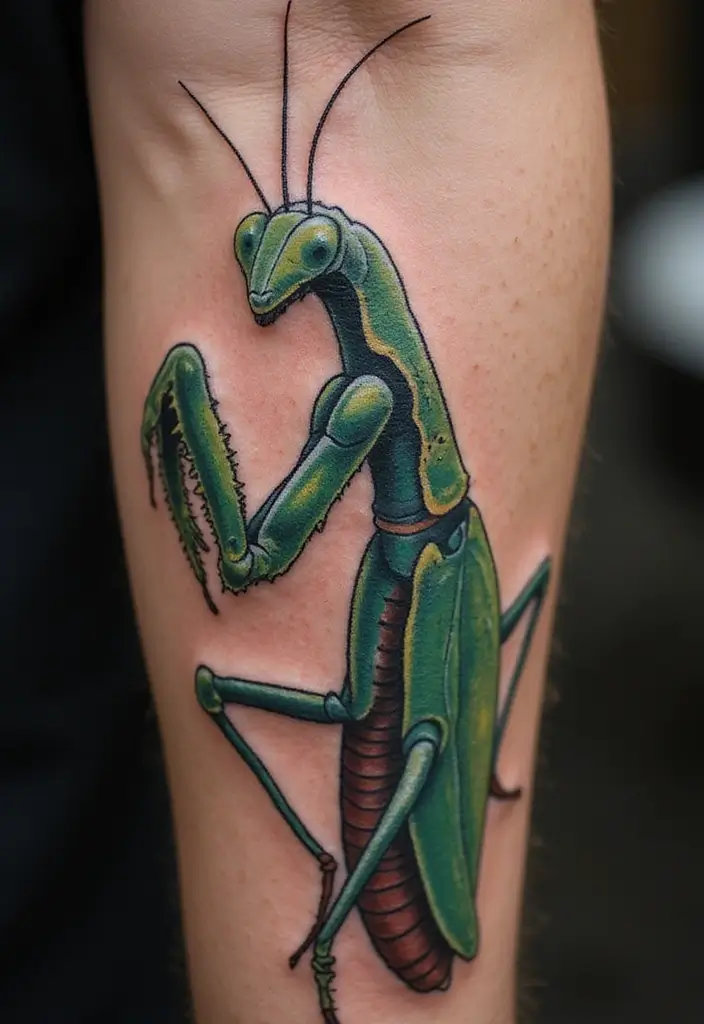
If you want to celebrate nature in detail, a realistic praying mantis tattoo can be a striking choice. It shows the insect with true colors, crisp lines, and careful shading that make it feel alive. Realistic tattoos rely on color blends and soft shadows to add depth. You’ll spot the tiny joints, the ribbed legs, and the glossy eyes when the piece is done well.
Design elements
– Use fine line work and subtle shading to show the mantis’s body segments and textures.
– Add natural touches like leaves or branches to frame the insect and create depth.
– Let light play across the shell to give a lifelike sheen without overdoing the color.
Placement and size
– Big areas like the back, shoulder, or thigh let you display intricate details.
– If you want extra drama, a forearm or calf piece can work with a carefully planned composition.
– Talk with your artist about a few sessions so the shading stays precise and not rushed.
Color and shading tips
– Choose greens, browns, and earth tones that fit your skin tone.
– Favor gradual fades over hard contrasts to keep the look natural.
– Check how the ink ages on your skin; realism thrives with clean, lasting lines.
Next steps
– Bring reference photos and discuss the shading style you prefer.
– Review the artist’s close-up work to ensure you’ll get the level of realism you want.
– Plan aftercare to protect the details as the tattoo heals.
8. Mantis in Flight
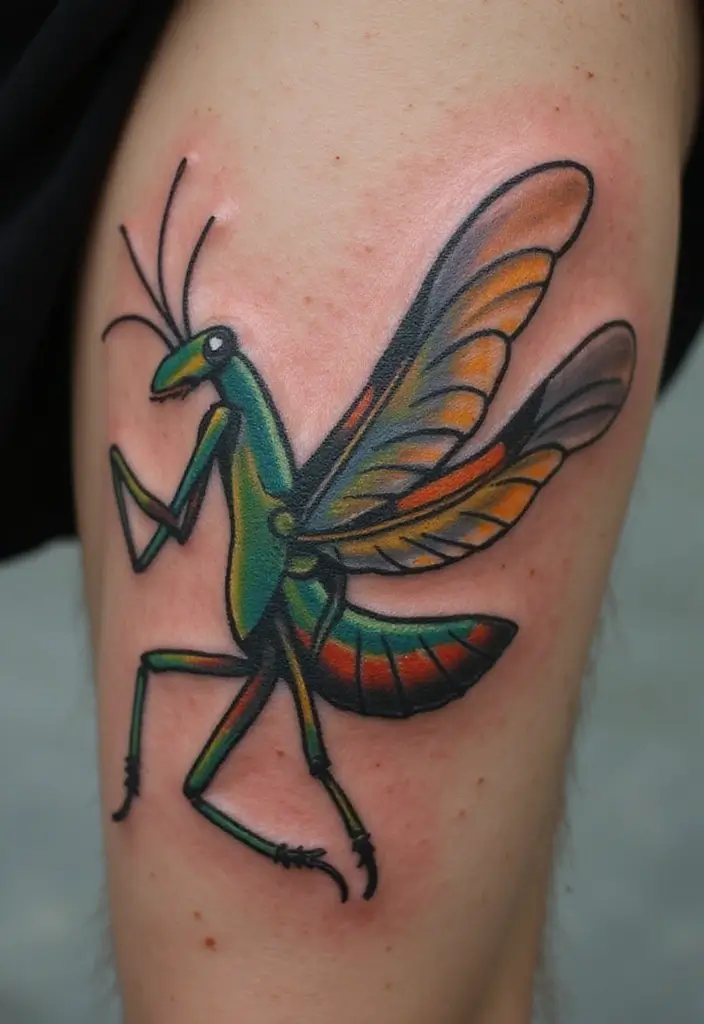
Are you after a tattoo that feels alive and fast? A mantis in flight gives that sense. You get energy and a fresh take on nature art. The pose shows the insect just lifting off, wings spread. Here is why it works: it tells a story of moving forward.
– Design ideas Use wind lines around the insect to show speed. A soft blur behind the mantis makes it pop.
– Placement tips The forearm or calf makes the motion easy to read from a distance.
– Color strategy Mix greens with earth tones for the body. Let the wings use lighter shades to stand out.
– Style options A fine-line approach keeps details clear. A watercolor wash adds a dreamy feel, but keep the palette simple for longevity.
– Practical notes Keep lines clean and avoid heavy shading on small sizes so the tattoo ages well.
Here is why you should bring references. Next steps: talk with your tattoo artist. Show photos of mantids in flight and ask for a simple line sketch first, then color. This helps you see the motion before you commit.
– Style notes If you want a bold look, use strong outlines and flat color blocks. If you want a soft feel, choose delicate shading and a gentle gradient.
Then you are ready to ink.
9. Mantis with Mandala
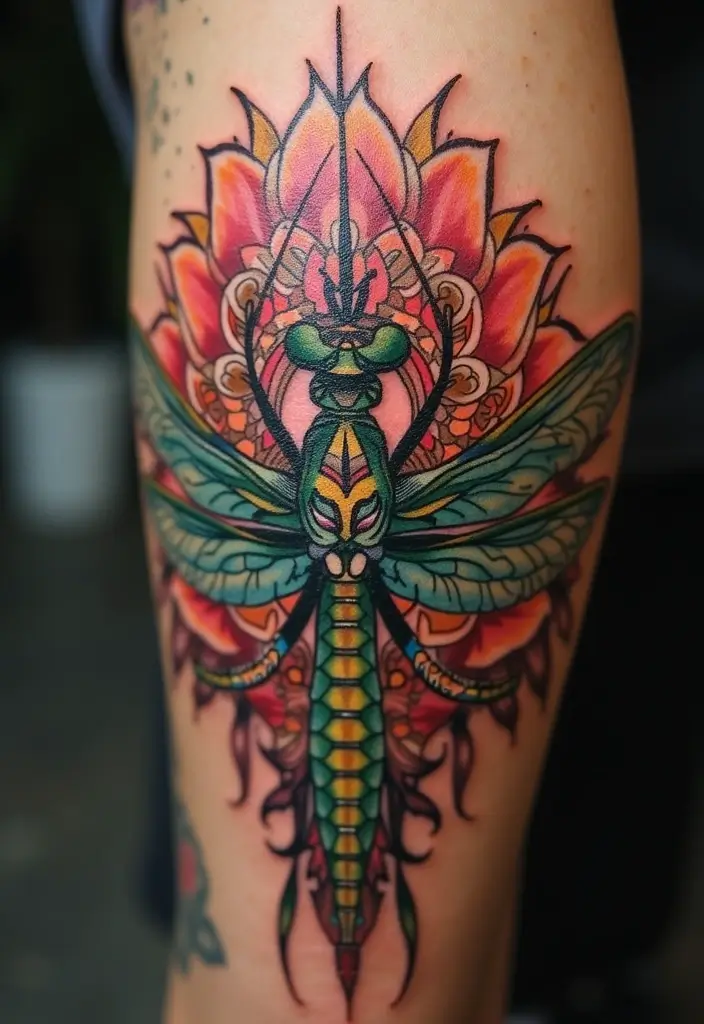
Are you after a tattoo that feels calm and real? A praying mantis paired with a mandala can give you that. The mantis stands for focus and patience. The mandala nods to unity and balance. Together they make a design that feels natural and mindful.
Here is why this combo works: the mantis sits at the center like a quiet moment. The mandala wraps around in circles, guiding the eye toward the insect. The result is a tattoo with clean lines, rhythm, and depth. You can keep it simple with line work or add soft shading for a gentle look.
Design Tips: Keep symmetric patterns around the mantis for a balanced feel. Try a bigger design on your back or chest so the mandala can bloom around the insect.
Placement ideas:
– Back
– Chest
– Forearm
– Calf
– Color or black ink both work. Color brings life; black ink gives a classic, crisp look.
Next steps: gather photos of mantis and mandala styles you like. Talk to a tattoo artist about a stencil that centers the insect. Check your skin tone and decide on size. This tattoo can mark a path to inner calm and steady confidence. Take your time to pick the right artist.
10. Symbolic Mantis
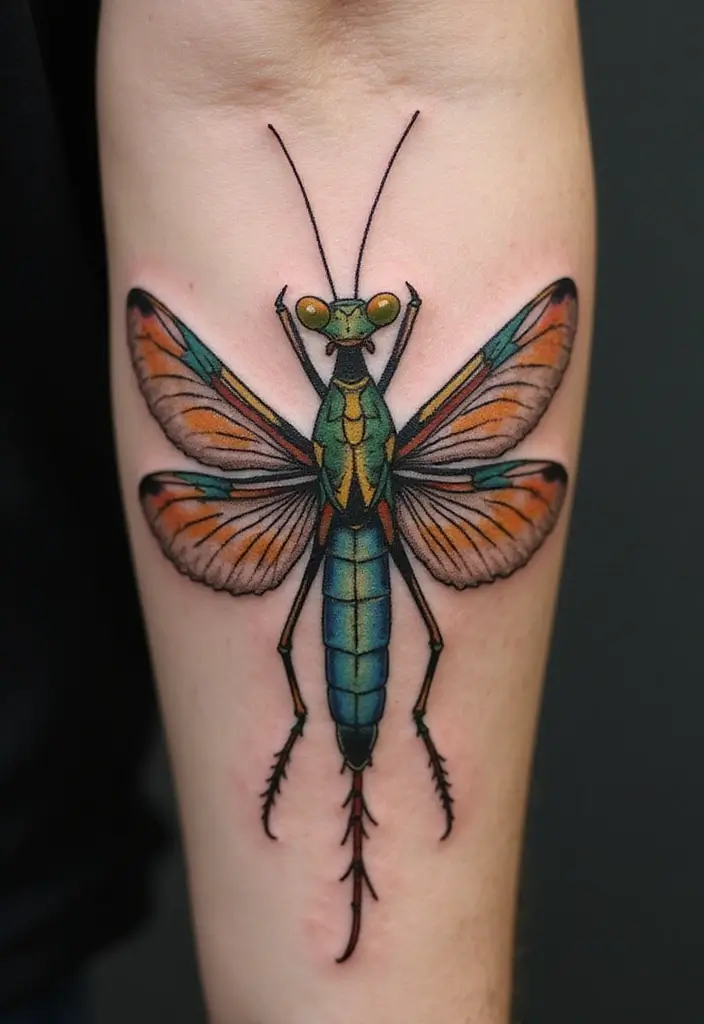
You want a tattoo that carries your own meaning. A symbolic praying mantis can give you just that. The mantis teaches patience and focus. It moves with care, never in a rush. You can map your life through small details that matter.
Here is how to build a design that speaks your truth. Choose symbols you feel connected to. Stars can mark guidance on dark nights. Waves can stand for strength through change. A compass or hourglass can mirror your journey. Keep the lines clean and the shading soft so the meaning stays clear over time. Color can highlight key ideas, but a simple black work lasts longer.
Placement Ideas: Start small if you want something discreet:
– A tiny mantis on the wrist or behind the ear
For more visible meaning, go for a forearm or collarbone piece:
– A medium design fits well here
If you want a big story tattoo:
– Place it along the back or side
Here you can weave several symbols into one scene.
This tattoo is more than body art. It becomes a living story you wear. Each line recalls a moment of patience, every shade hints at a choice you made. You look at it and remember who you are and who you want to be.
11. Mantis and Insects
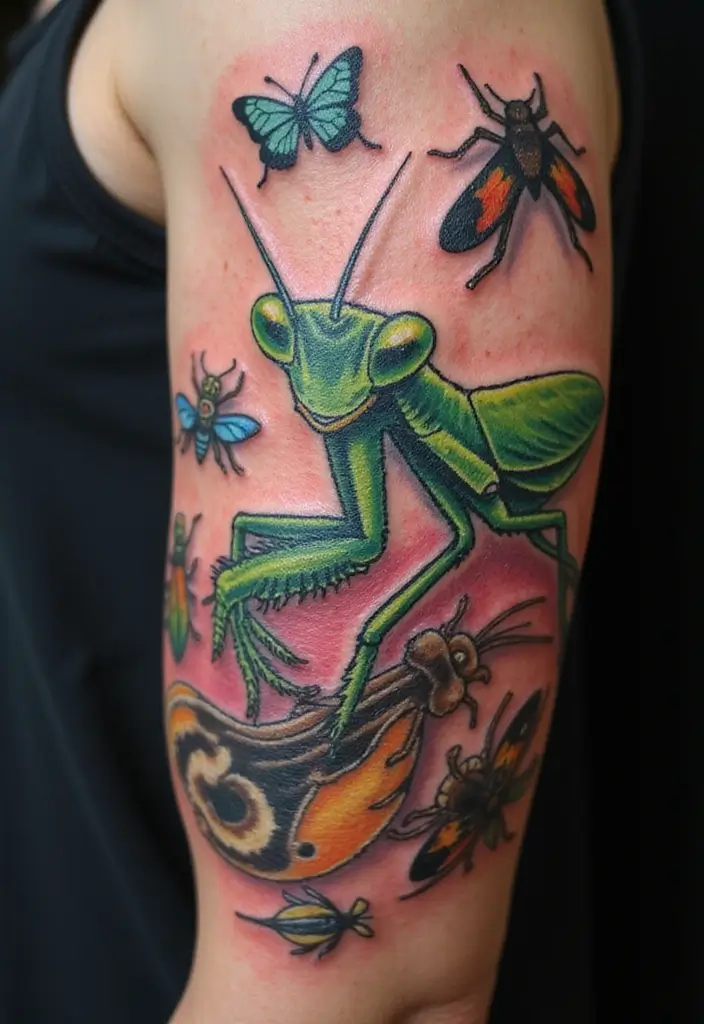
Want a tattoo that tells a living story? A praying mantis paired with other insects can show how life stays connected. It adds motion and meaning without crowding the design.
Here is why this idea can shine on your skin. It brings contrast and texture. You get a scene with space to breathe, not just a single bug.
– Design around the mantis with butterflies, ladybugs, or bees to show a small ecosystem.
– Use different colors for each insect so they stand out yet stay harmonious.
– Place the scene on a larger canvas, like the back, shoulder blade, or thigh, to capture fine details.
– Add subtle background elements such as leaves or tiny flowers to frame the group.
Strong lines keep the mantis clear; soft shading makes the other insects look light and lively.
Next steps: talk with a tattoo artist about a layout that fits your skin tone and body shape. Ask for a few ink options: bold lines for a crisp look or a watercolor style for a dreamy feel. Any color fades? They can plan color blocks that age well.
This approach celebrates nature’s variety while giving you a unique, eye-catching piece. You can start with a rough sketch to test the idea.
12. Mantis with Celestial Elements
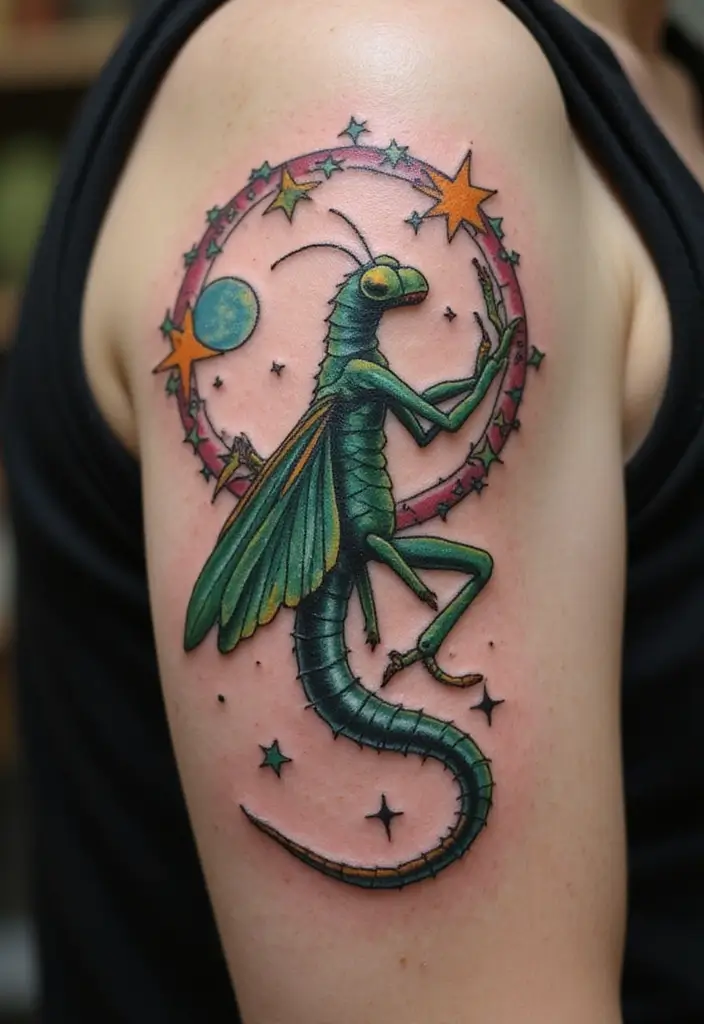
You want a praying mantis tattoo that looks grounded and cosmic at the same time. This guide helps you plan a design that stands out and fits your vibe.
– Concept and meaning: Add stars, moons, or planets around the mantis to give a sense of guidance and celestial mystery. The mantis acts as a calm observer in a wide night sky. This setup shows a link between nature and the bigger world above.
– Design ideas: Put the mantis at the center with a halo of tiny stars. Or place a soft moon behind it to create depth. Let the stars sweep around the body part you choose. The look works well on the upper arm or the back, where there is room for detail.
– Style tips: Use crisp linework for the mantis and gentle shading for the sky. Try dotwork for small stars and a soft watercolor wash for color. Pick a palette like midnight blue, gray, and white, or go bold with black and silver.
– Practical steps: Decide size first. Bring a rough stencil to your artist. Ask for a few test angles to show how the light hits the mantis.
– Care and reality: Aftercare matters. Keep the skin clean and moisturized. Avoid direct sun while it heals.
– Why this helps you: The design blends nature with the cosmos, giving a tattoo that feels present and timeless.
13. Mantis on Branch
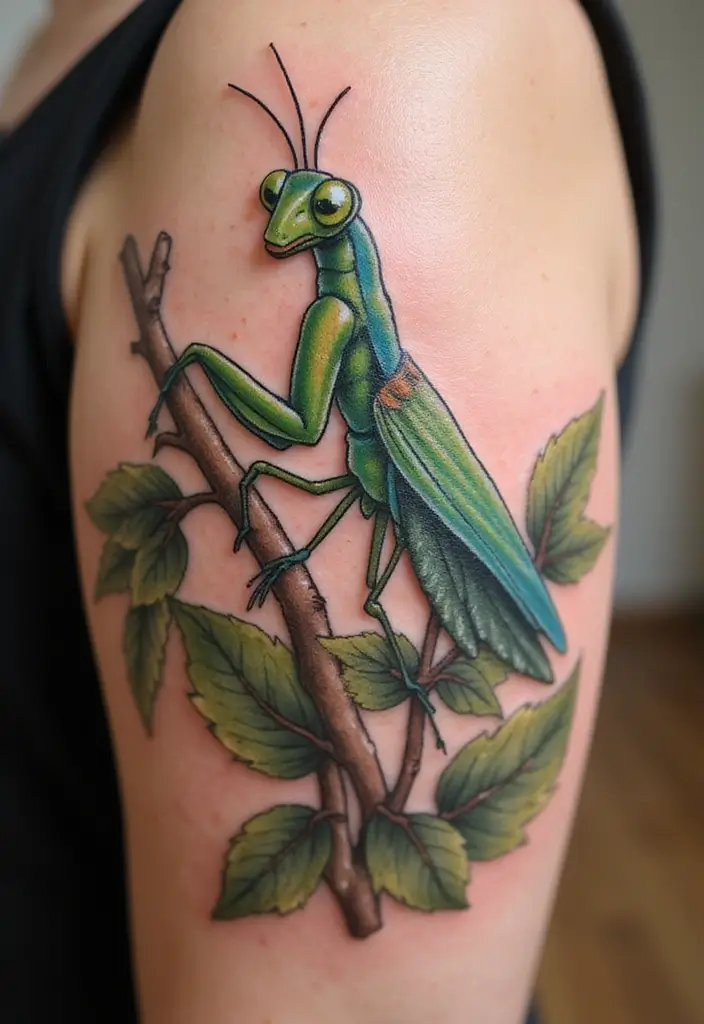
If you want a tattoo that feels calm and true to nature, this design fits. A praying mantis on a branch keeps the scene simple yet alive. It speaks of focus, patience, and the quiet beauty of still life.
Picture the mantis perched on a thin branch. Add leaves or tiny flowers to soften the lines. Use earthy hues like olive and brown so the mantis stands out.
Placement Tips:
– Forearm or side works best, with the branch tracing along your skin.
– Let the branch run diagonally to guide the eye.
– Choose textures: crisp bark for realism, soft shading for a dreamy look.
– Use earthy colors to keep the scene natural while the mantis pops.
Line work and shading keep the design clear. Thin lines for legs and antennae add elegance. Stronger lines for the branch give stability. If you want color, a soft watercolor wash around the leaves adds life.
Next steps: ask your artist to sketch the branch first, then add the mantis. Bring branch photos you like. Test color swatches on paper or skin. Size it to fit the area.
This tattoo invites you to slow down and notice small things. It stays calm even on a busy day.
14. Mantis with Abstract Art
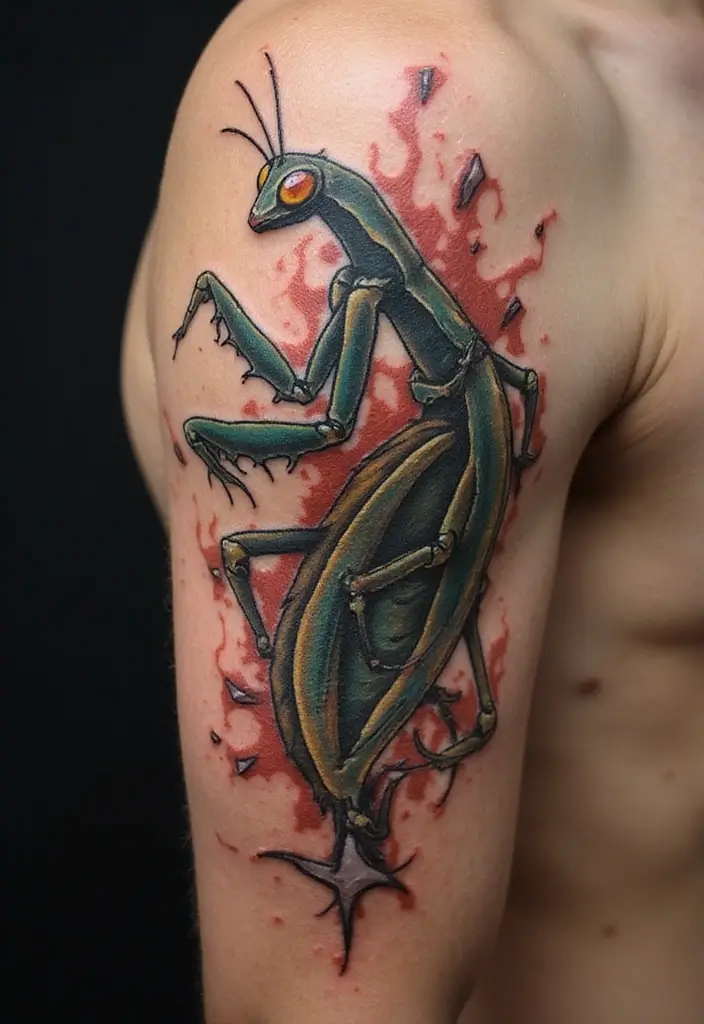
You want a tattoo that feels fresh and personal. A mantis with abstract art can give you that.
Color splashes and flowing lines form the mantis. Shapes swirl around its body, and the piece reads as a living moment on your skin. This style adds depth and invites your own meaning.
Benefits show fast. It is eye catching and easy to scale up or down. You can wear it bold or subtle, depending on color choice and size.
– Color ideas: Choose bold colors for strong contrast or soft tones to set a calm mood.
– Shapes and lines: Let curved forms mingle with sharp edges for a lively look.
– Texture and technique: Try watercolor splashes or clean ink lines to add depth.
– Placement and size: Put it on the thigh or upper arm and adjust the size to fit your plan.
To make it work, bring references to your artist. Ask for a rough stencil first, then tweak the colors and flow. Think about skin tone and how the ink will hold up over time. This is not just insect art; it is a wearable piece of art you carry.
15. Minimalist Mantis
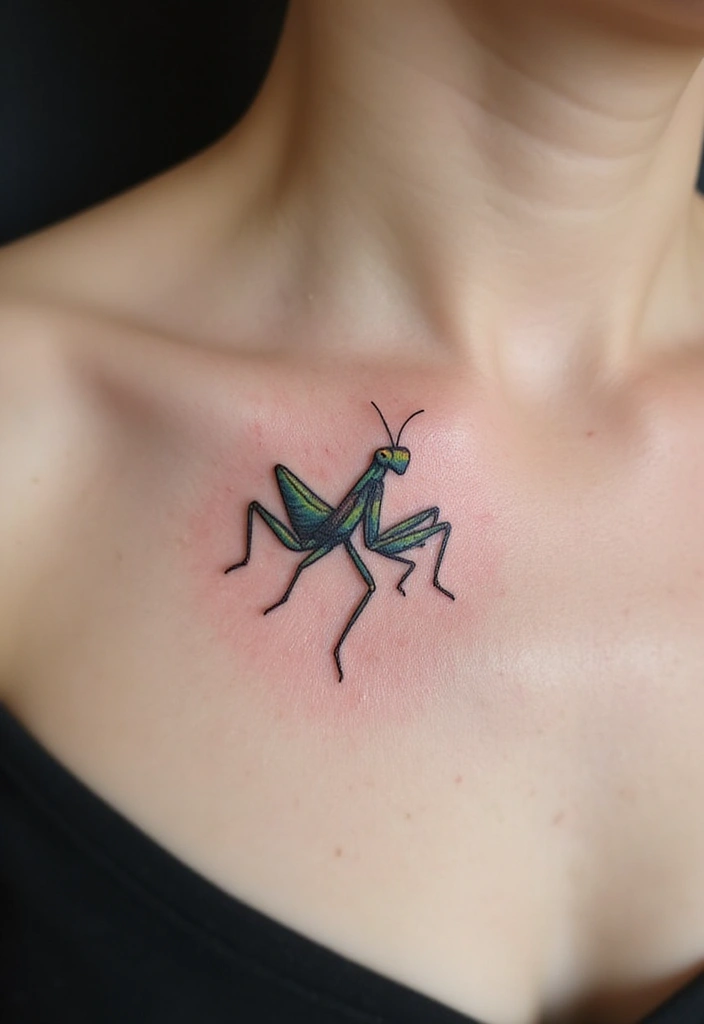
If you want a praying mantis tattoo that stays clean and timeless, a minimalist design fits. It uses simple lines and light shading to show the mantis without clutter.
This style keeps the focus on shape and balance. It reads clearly from a distance. It feels precise, almost like a sketch you would see on paper.
Why choose this look? It’s subtle, versatile, and easy to place on small areas. It works well for first tattoos or for a quiet, professional vibe. You can wear it daily and still keep it classy.
Here are practical ideas to guide your talk with the artist.
– Placement ideas: wrist, ankle, or behind the ear. These spots let the mantis’s simple lines shine without shouting.
– Ink options: Black ink gives a classic feel. A single color splash can add life without breaking the clean lines.
– Technique tips: Ask for crisp line work with even thickness. Keep shading minimal, perhaps a tiny shadow under the body for depth.
– Care and longevity: Keep the skin moisturized, avoid sun exposure for the first weeks, and follow your artist’s aftercare. A clean design ages gracefully.
Next steps: compare artists who specialize in line work and minimalist mantis pieces. Bring a simple reference, ask to see a stencil, and imagine how it will look in different lighting.
16. Mantis with Quote
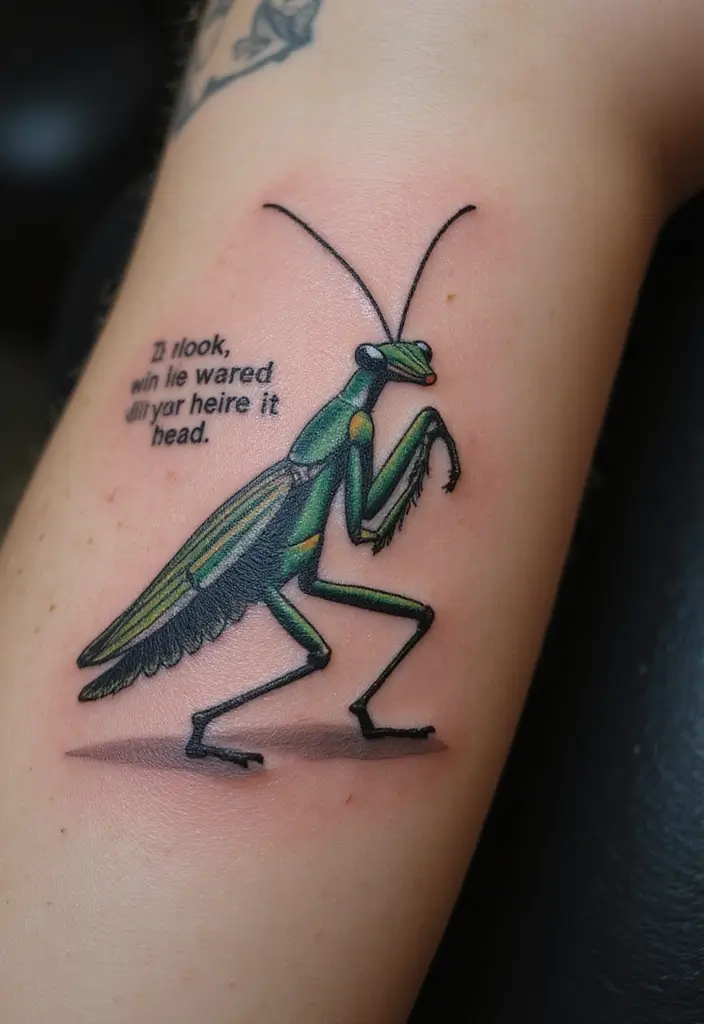
You want a mantis tattoo that also carries a message. A meaningful quote can make the piece last longer in your mind.
Here is why: the mantis itself stands for patience and focus. A short line can echo that idea and keep you grounded every day.
Let’s break it down. How do you pick a quote?
– Pick a theme: nature, mindfulness, or personal growth.
– Keep it short: two to six words or a simple, clear line.
– Choose a readable font and size that fits your ink.
Placement and design matter too.
– Forearm or ribs give space for both the insect and the words.
– Let the quote follow the line of the mantis, not fight against it.
– Test the layout with a stencil before you commit to ink.
Design ideas to try.
– MantIS with a curved banner that holds the quote.
– Put the words along the leaf stem or along a wing edge for a natural flow.
Practical steps to take now.
– Bring a few quotes you like to your artist and ask for a dry run.
– Talk about line weight and shading so the text stays legible as you age.
– Start with black ink; add subtle grays if you want depth.
Next steps. Start with a short list of quotes, visualize two layout options, and then hit the studio with confidence.
17. Mantis with Butterfly
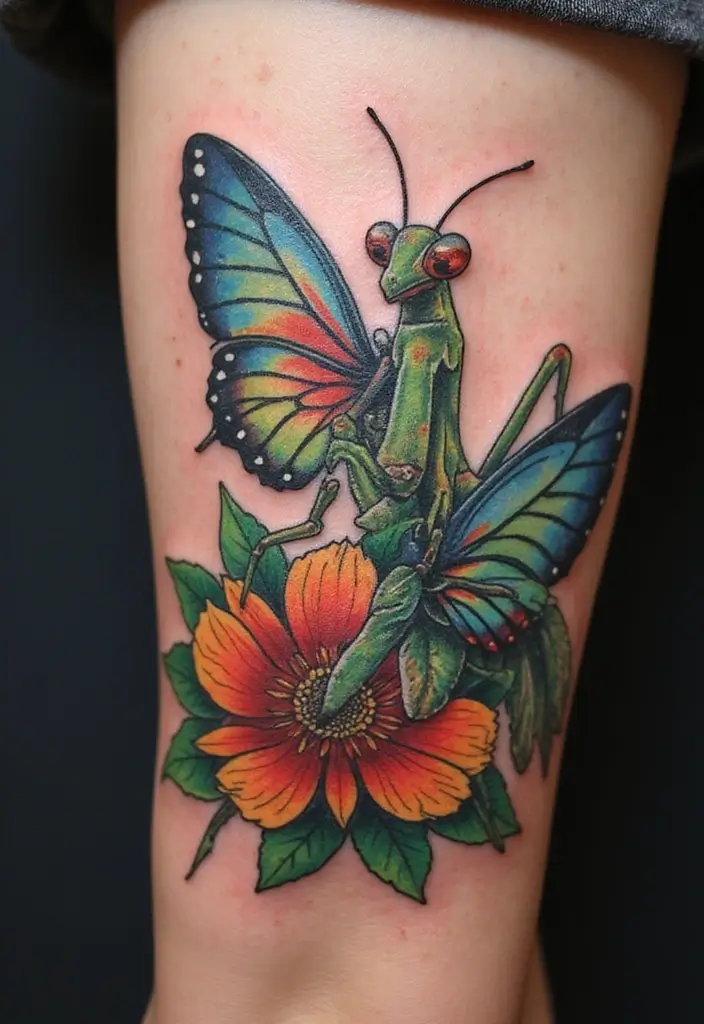
You want a tattoo that shows your journey. A mantis with a butterfly does just that. The mantis stands for patience. The butterfly stands for change and beauty. Together, they tell your growth story in a single image.
Design Suggestions:
– Position the mantis as if it is watching the butterfly. The moment feels real and tells a tale.
– Use bright colors for the butterfly and softer greens or browns for the mantis. Big areas like the upper arm or back suit this combo.
– Blend styles to fit your style. Crisp linework keeps the bugs clear, while gentle shading or a touch of watercolor gives life to the wings.
– Consider a scene where the mantis interacts with the butterfly, adding a sense of motion.
This design represents resilience, growth, and the beauty of transformation. It speaks to your patience, your ability to adapt, and your new beginnings.
Next steps: collect references, discuss size and placement with your artist, and review a mock stencil to see how it fits your skin.
18. Vintage Style Mantis
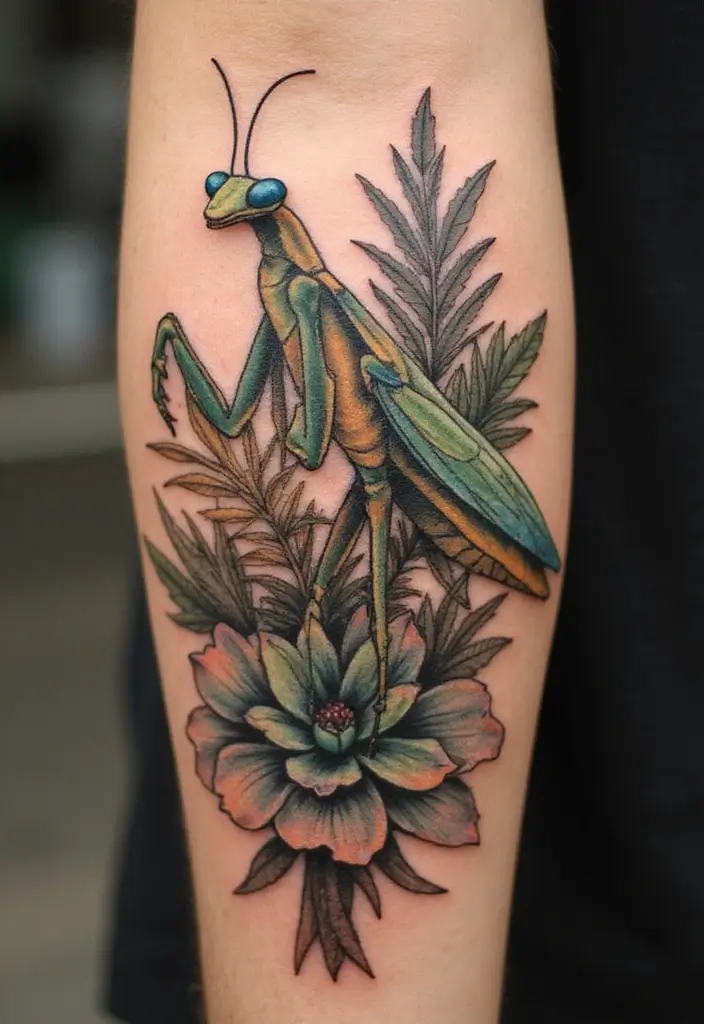
If you want a tattoo with real old school charm, try a vintage style mantis. This look uses retro lines and muted colors to feel like a worn postcard from the past. The mantis can wear classic motifs that tell a small story. It’s not loud, but it has depth you can see up close.
Design Elements:
– Bold outlines with a soft wash of color keep the piece readable over time.
– Banners, scrolls, or floral accents echo traditional tattoo art.
– Subtle shading adds texture, like rain on a leaf or sun on metal.
The palette stays gentle: olive greens, browns, creams, and a touch of gray. This keeps the mantis looking natural and timeless.
Placement matters. You’ll get the best view on the upper arm or the chest, where the lines can breathe and the details stay clear.
Here is why it works for you. It celebrates the craft of traditional tattoos while honoring nature. It pairs well with other old school pieces already on your skin.
Next steps: bring reference images of vintage tattoos you love. Talk with your artist about bold outlines and softer shading. Ask for a faded, sun-washed finish that ages nicely. Keep expectations practical and enjoy the story this piece tells on your body.
19. Splattered Ink Mantis
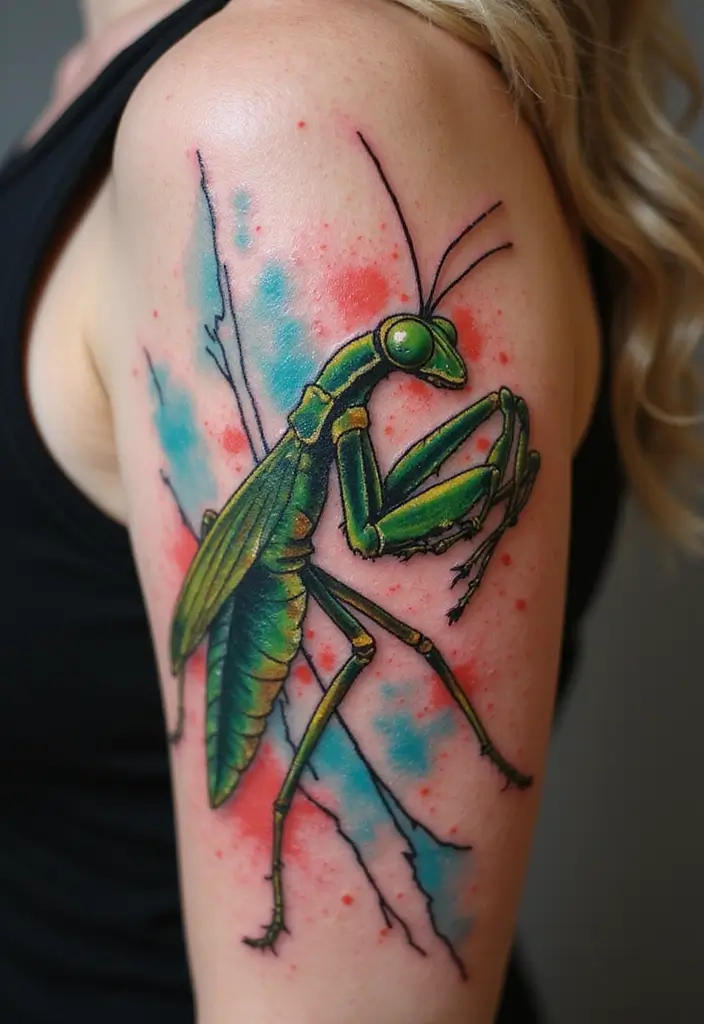
If you want a bold, artsy look, the splattered ink praying mantis tattoo fits you. It blends sharp lines with messy color sprays, making the mantis feel alive. The ink splatters give a sense of chaos and freedom, yet the insect stays clear.
What it looks like: A clean mantis silhouette with color bursts splashed around and across it. The result mixes precise drawing with paint-splatter texture. The colors pop and blend, so the tattoo reads like moving art.
– Placement options: Choose a large area so the splashes can flow freely. Back, thigh, shoulder blade, and calf work well. For a bigger statement, go for a full sleeve or chest piece.
– Color and mood: Bright reds, electric blues, sunny yellows, or neon greens read as energy and life. The splatter edges add a playful chaos that fits a creative personality.
– Tips for getting it right: Pick an artist who can handle spray-style shading and drips. Start with a clear mantis silhouette, then let color bursts extend beyond the lines. Keep the ink vibrant with proper aftercare.
– Next steps: Ask for a color test and a placement sketch before you ink.
20. Realism with Fantasy Elements
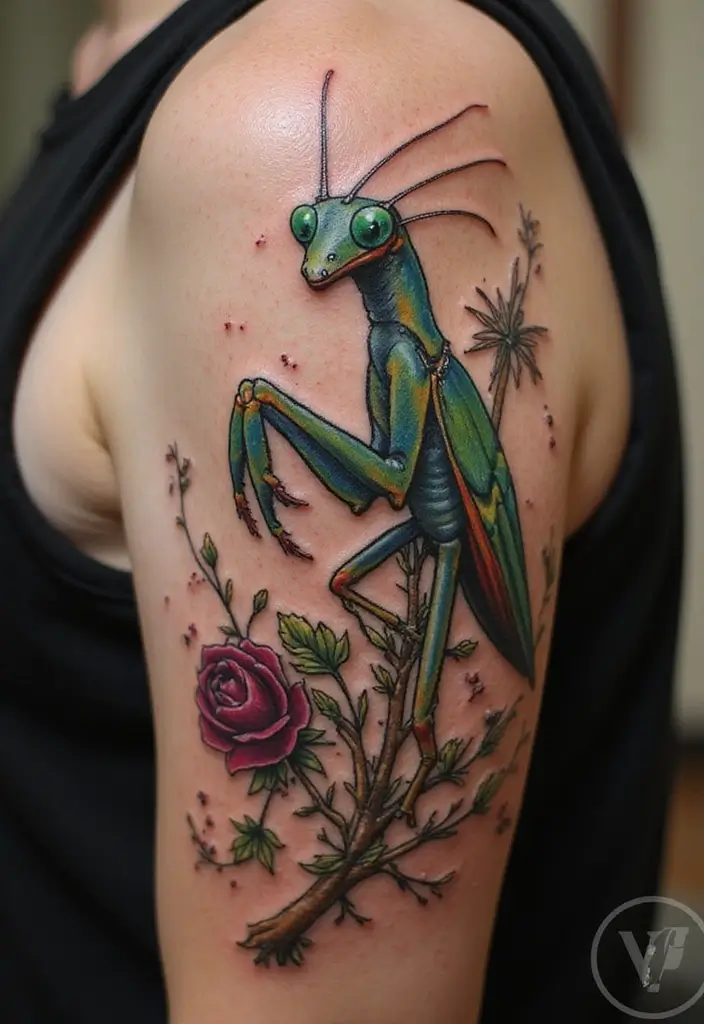
Here is why you should mix realism with fantasy in a praying mantis tattoo. You get a piece that feels true to life but carries a spark of myth.
– Design ideas:
Start with accurate anatomy. Crisp linework shows the legs, eyes, and stance.
Use light shading to add texture on the shell and joints.
Add a fantasy touch such as fairy wings or a gentle glow around the insect. Let it feel integrated, not hiding the mantis.
Include stars, mystical plants, or a soft color halo to signal magic.
– Placement and style:
Large canvases like the back or chest help the work breathe.
Let color layer in slowly for depth and shine.
Try watercolor for a dreamy glow or dotwork for sharp edges and clean lines.
– Practical steps:
Gather real life mantis photos and fantasy art to guide your idea.
Sketch rough layouts and then refine with your artist.
Pick a limited color plan to keep the scene cohesive.
Use test stencils to see how fantasy elements sit with the real form.
Next steps: talk with a tattooist who can balance true detail with magical flair.
Take your time with the idea and share it in parts.
Bring references that show mood and color.
Your artist will blend them into a single piece.
21. Mantis and Nature Scenery
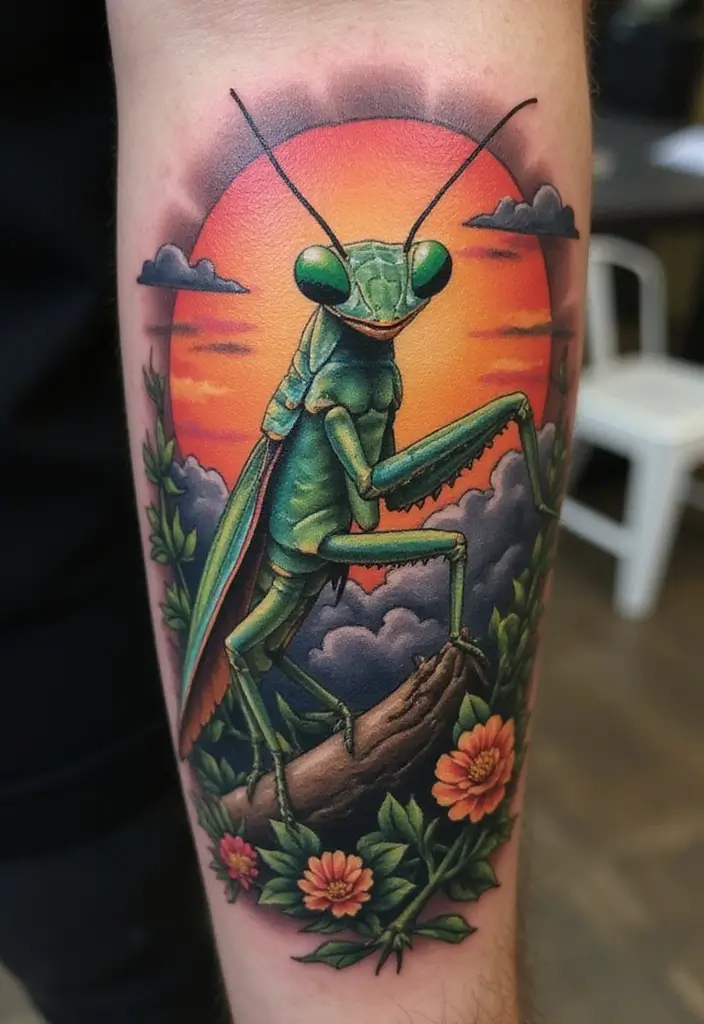
Nature on your skin: Mantis with scenery
You want a tattoo that shows your love for nature. A praying mantis paired with a landscape is a strong match. The mantis stays sharp as the scene breathes. Here’s how to make it work.
Design ideas
– Place the mantis among trees, mountains, or a winding river. Let it remain the focal point.
– Match colors to the scene instead of making the insect stand out too loud. Use greens and browns for foliage, blues for water, and cool grays or whites for peaks.
– Add small touches you love, like a distant bird, a sun glow, or a river mist.
Placement and style tips
– Large areas work best, like the back, chest, or thigh. The scale lets every detail read.
– Let the landscape curve with your body to stay alive. Ask your artist to keep the mantis clear in busy scenery.
What you gain
– A piece that tells a natural story with a quiet, confident insect at the center.
– A design that ages well and stays true.
– You can adjust later for brighter colors.
Next steps: gather reference images, pick a color mood, and talk to a tattooist who loves outdoor scenes.
Take your time.
22. Four Seasons Mantis
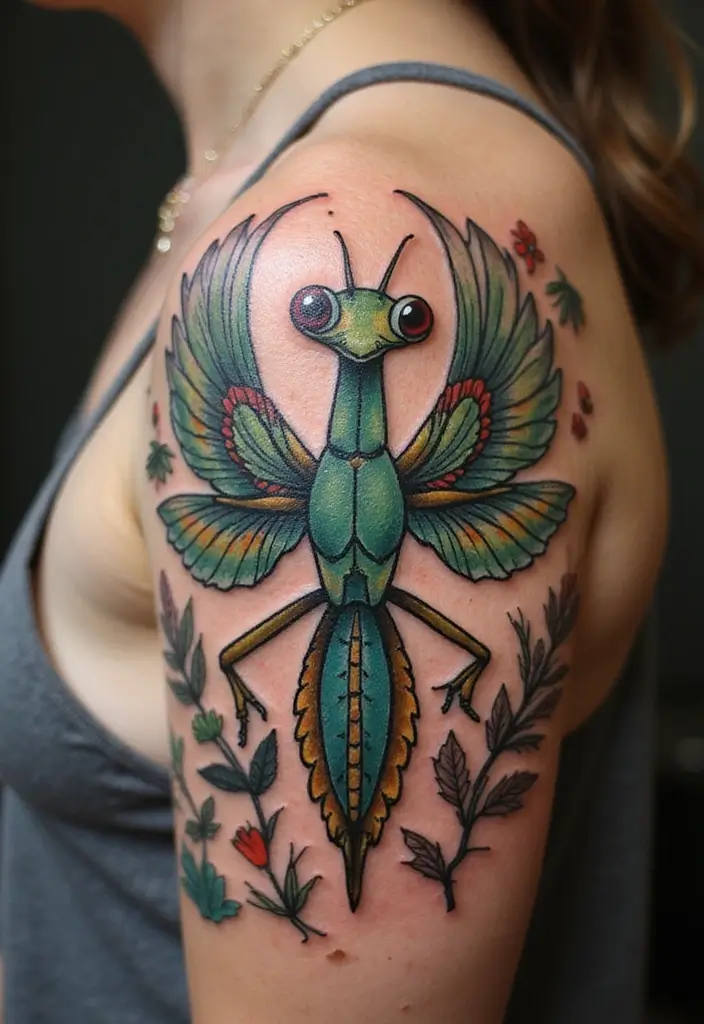
The Four Seasons Mantis tattoo shows how life moves with the year. You put a praying mantis at the center and add four season scenes around it. It mirrors growth, change, and resilience as the days go by.
Design Suggestions: Use small details for each season around the mantis. This makes a clear, readable story you can see at a glance. The back is a great place for this piece. It lets you add fine lines and rich textures without feeling crowded.
– Spring: tiny flowers, fresh green leaves, soft buds
– Summer: bright sun, lush foliage, a warm glow
– Autumn: amber leaves, acorns, a breezy feel
– Winter: snow flecks, bare branches, cool shadows
Here is why this design works well for you. It combines a strong central image with four seasonal accents. The symbolism is simple: growth, change, and what it takes to endure each season. You can keep the colors gentle or go with crisp black ink and subtle shading.
Placement and style tips: Choose a large surface to let every detail breathe. A back piece fits best, but a full sleeve or chest panel can also work if the artist plans the flow carefully. Keep the lines clean for longevity.
Next steps: gather season references you love, and talk with an artist who handles nature details. Decide on a color plan and a shading style that stays clear over time. This tattoo can honor life’s cycles in a bold, thoughtful way.
23. Mantis with Insect Family
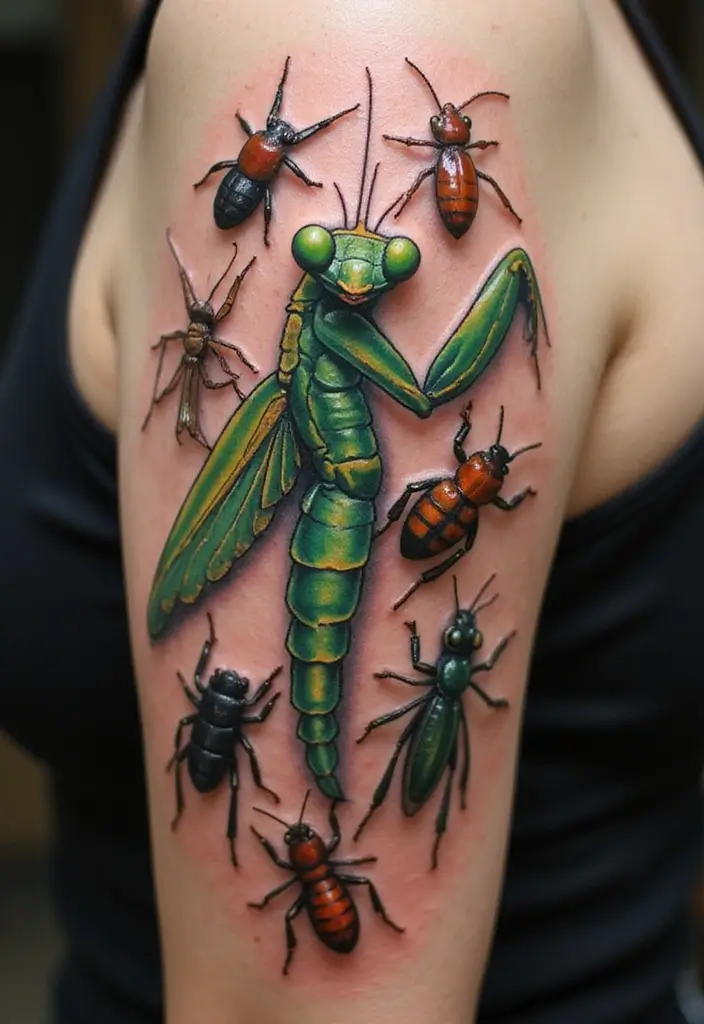
A mantis can share the stage with other insects to tell a tale about life in nature. If you want a tattoo that shows a small family tree of bugs, this idea works well. Picture a praying mantis at the center with companions like ladybugs, dragonflies, or beetles circling around. The result is a piece that celebrates life in all its forms and our place in the web of nature.
What the design means
Each insect stands for something different. The mantis is calm and focused. The ladybug brings luck. The dragonfly hints at change and swiftness. Beetles can symbolize resilience. Together they form a story you wear on your skin.
Design tips
– Use colors that pop but stay harmonious. Let the mantis stay green, the ladybugs bright red, and the dragonfly a shimmering blue or teal.
– Keep a similar line weight so the tattoos feel part of one scene.
– Place this on a larger canvas. The arm, shoulder, or back give room for fine details.
– Mix styles carefully. A clean line work look blends with soft shading for depth.
Next steps: talk with a tattoo artist about an accurate stencil, test small color swatches on skin, and plan a multi-session session if needed. This design honors nature and all creatures within it.
24. Mantis in Zen Style
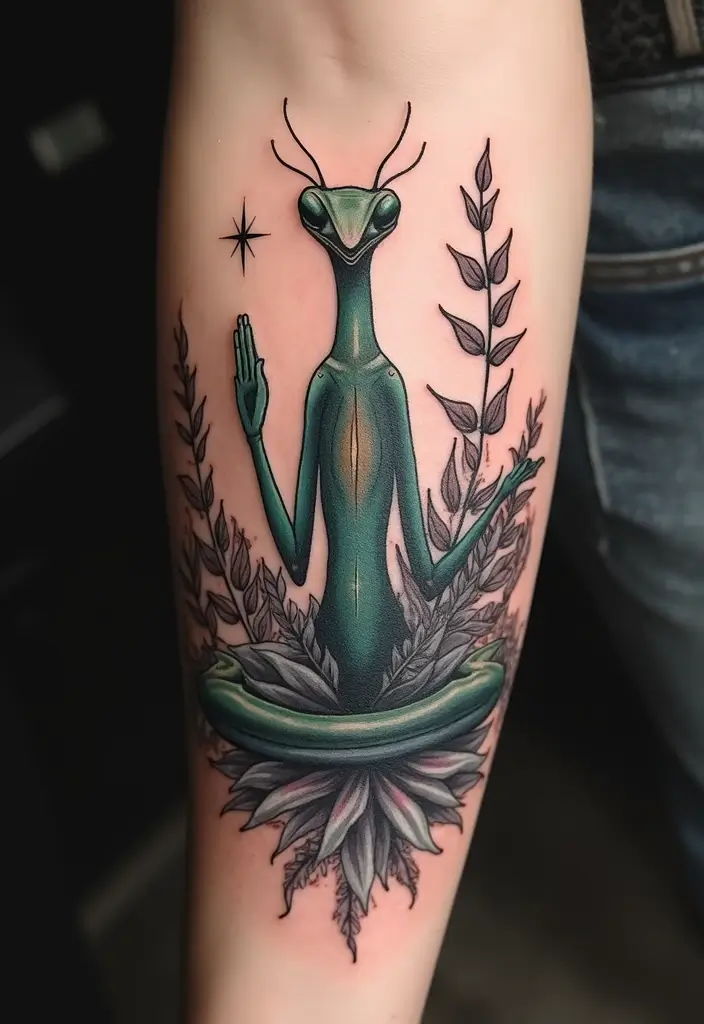
Looking for a tattoo that feels calm and grounded? A praying mantis done in a Zen style might be your perfect match. This design centers on peace, balance, and steady focus. The mantis sits in a meditative pose, framed by simple, tranquil details.
Design elements:
– Lotus flowers to express purity and inner calm
– Bamboo stalks for strength and flexibility
– Soft shading and clean lines for a quiet, contemplative look
Placement ideas:
– Upper arm offers a neat, visible reminder to stay grounded
– Back gives space for a larger, more detailed scene that breathes
This tattoo is more than art. It can be a small daily practice you carry with you. The mantis symbolizes patience and focus. It nudges you to slow down and breathe.
Practical tips:
– Choose a palette of earthy tones or subtle greens to keep the Zen vibe
– Keep the lines crisp for a timeless feel
– Talk to your artist about scale so the pose reads clearly
– Plan for a soft fade if you want a serene finish
Next steps: gather reference images of a meditating mantis plus lotus and bamboo motifs. Decide on size, placement, and color before you sit for the stencil.
Embrace tranquility with a traditional praying mantis tattoo! Symbolizing peace and focus, this Zen-inspired design invites a sense of calm into your life, just like the gentle pose of the mantis itself.
25. Mantis with Art Nouveau Style
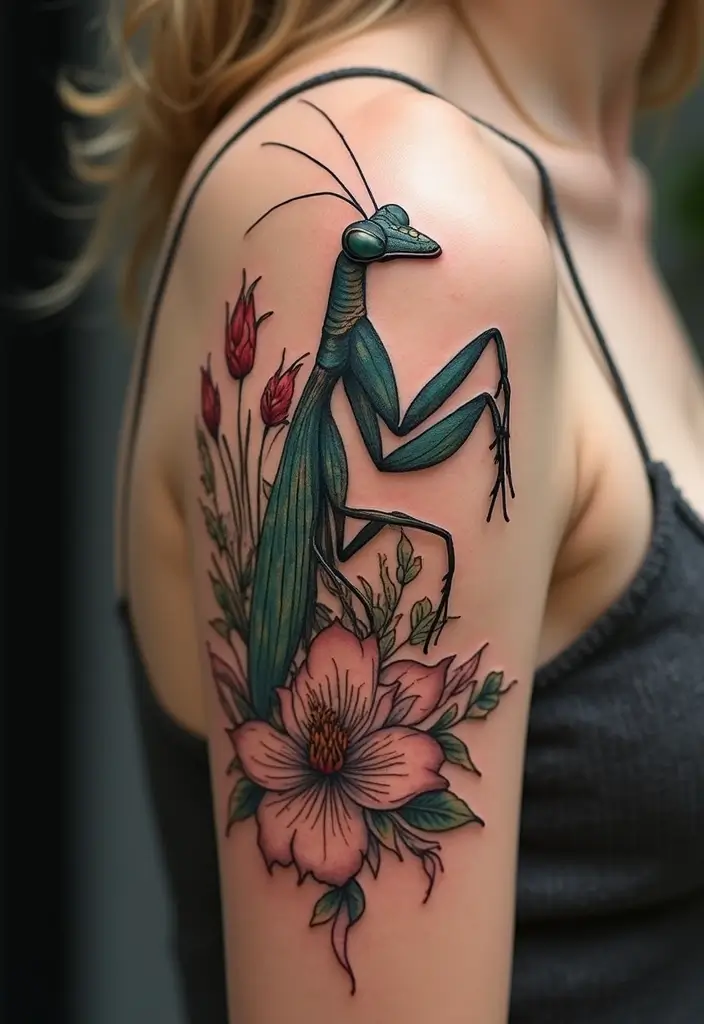
If you want a tattoo that feels like living art, a praying mantis in Art Nouveau style fits the bill. This look uses smooth curves and natural shapes to turn the insect into a piece you can wear.
It feels calm and refined. The lines flow across the skin, guiding the eye along the mantis’s body. The wings, antennae, and legs are simplified into graceful swirls that echo nature.
Design Tips: Plant flowers and curling vines around the insect to frame it. Let the lines sweep in gentle waves to create movement. Keep the linework clean and slender for a delicate finish. For color, go subtle with soft greens, browns, or even a clean black and gray palette. Place this tattoo on a larger canvas like the back, thigh, or shoulder blade to let the details breathe. Size matters; bigger gives you richer shading and texture on the wings.
This style blends nature and art. It rewards careful shading and steady hands from your tattoo artist. If you are drawn to timeless beauty plus nature, this Mantis Art Nouveau piece could be your perfect match.
Ask your artist to show a small mockup first. Then adjust details. That way the final piece fits your body best.
Embrace the elegance of nature with a traditional praying mantis tattoo in Art Nouveau style – where each curve tells a story and every line flows like a gentle breeze.
26. Mantis with Heart
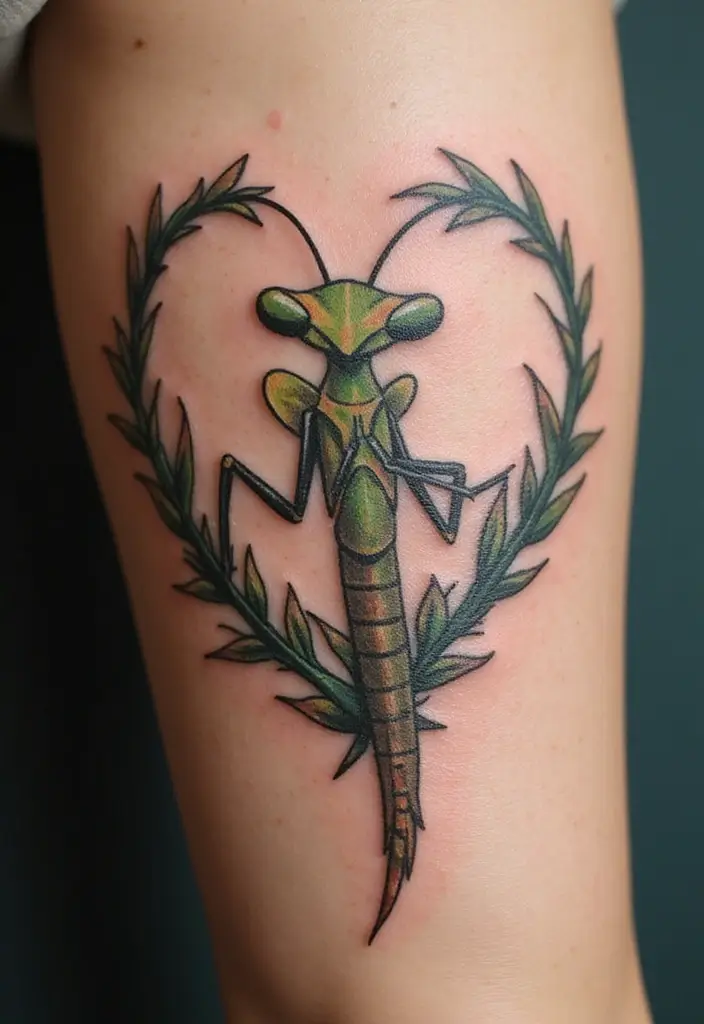
If you want a tattoo that blends love with nature, a praying mantis with a heart is a strong choice. It ties passion to the natural world. You get a design with personal meaning you can wear every day.
Here is why it works. The mantis adds a sense of focus and life. The heart keeps the message warm and clear. You can place this piece where it matters most to you, like near your heart or on the wrist, so it stays meaningful.
Design suggestions:
– Mantid cradling a heart in its forelegs for a natural, gentle pose
– Heart in bright red or soft pink to pop against the mantis
– Clean linework with light shading for a modern look
– A subtle watercolor wash around the heart adds a touch of artistry
Placement and style tips:
– Best spots: wrist, inner forearm, or over the heart
– Size: small for daily wear, medium for clearer details
– Style options: crisp blackwork, light shading, or a gentle color burst
Next steps are simple. Gather a few reference images you like. Talk with your artist about a clean silhouette and a bold heart. Ask for a design that stays true to the mantis while honoring your personal meaning. You’ll get a tattoo you can cherish and show with quiet confidence.
27. Mantis with Nature Symbols
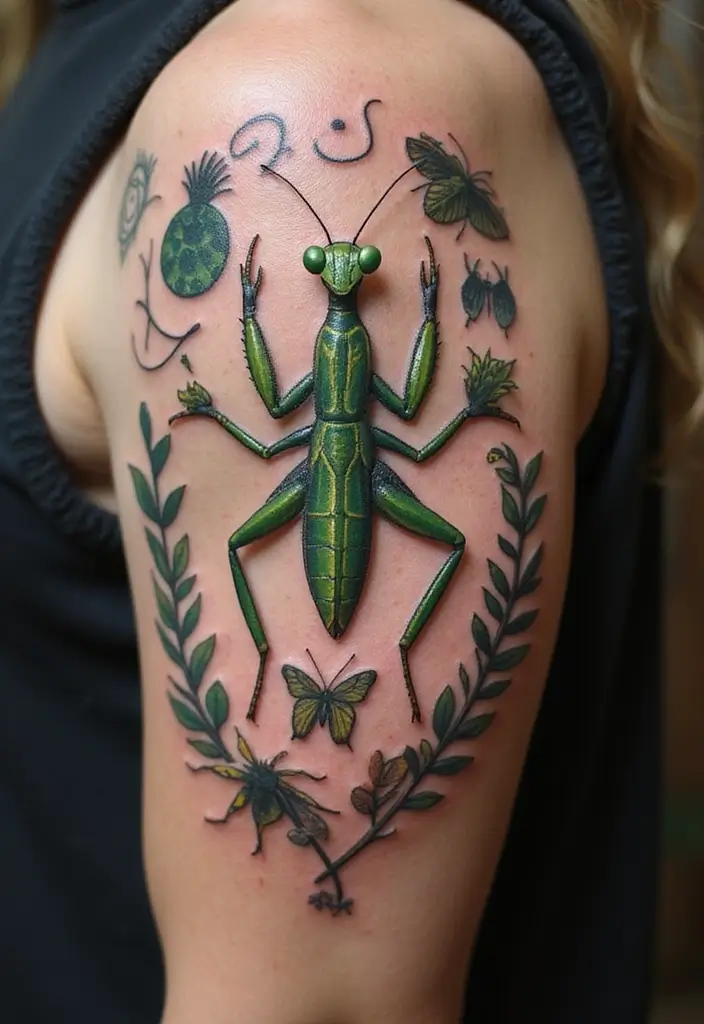
You want a praying mantis tattoo that feels rooted in the outdoors. Pair the mantis with nature symbols like trees, water, or mountains. Each symbol adds a natural story to the art and gives your tattoo more depth. The mantis can sit inside the scene, showing how it moves with the land. Here is why this idea works.
Design ideas
– Colors reflect the symbol, greens for trees, blues for water, and earthy browns for earth.
– Size works best on large canvases like the back or chest to show detail.
– Try styles like crisp line work, soft watercolor washes, or realistic shading.
– Add texture by showing leaves on branches, water ripples, or rocky mountain surfaces.
– Place the mantis perched on a branch or rock inside the scene.
– Leave negative space so the mantis stays clear and readable.
– Think about symbolism of each element and how it fits your life.
– Placement ideas include back, chest, shoulder blade, or thigh.
– Bring reference images and discuss flow with your artist before you start.
Next steps: plan the scene, pick color notes, and book a consult to see how the design wraps your body.
This combo can give you a calm, nature infused piece you wear with pride every day.
28. Mantis with Crystals
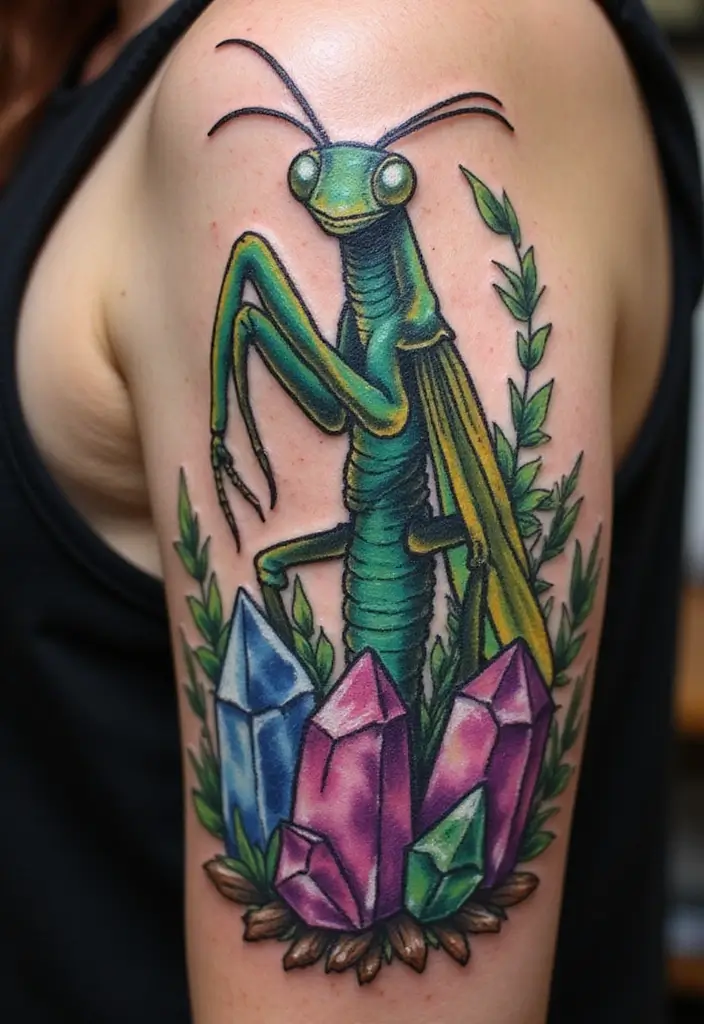
If you want a mantis tattoo that feels misty and meaningful, add crystals. The stones imply healing, energy, and protection. They lift the image from simple insect art to a compact story you can wear.
Here is why crystals fit a mantis scene.
– Design ideas: place crystals in the mantis’s world—glassy clusters among leaves, on rocks, or hanging like dew. This keeps the focus on the insect while giving the setting a magical glow.
– Mantis with crystals: show the mantis gently holding a crystal shard with its front legs, as if guarding a small beacon of light. It adds a quiet, protecting vibe.
– Crystal halo: frame the bug with a ring of tiny crystals. It creates depth and catches light from different angles for a luminous effect.
– Wing reflections: let crystal facets reflect in the mantis’s wings. The glassy shine changes as you move, creating a dynamic look.
– Color and style tips: pick crystal colors that match their meanings—clear quartz for bright energy, amethyst for depth, rose quartz for warmth. Add white highlights to mimic glass.
– Placement and scale: larger canvases like the back, shoulder, or thigh let the details breathe. Work with your artist on line weight and shading.
Next steps: bring these ideas to your tattoo artist, review references, and plan a clean, detailed piece that ages well.
29. Mantis with Astrology Symbols
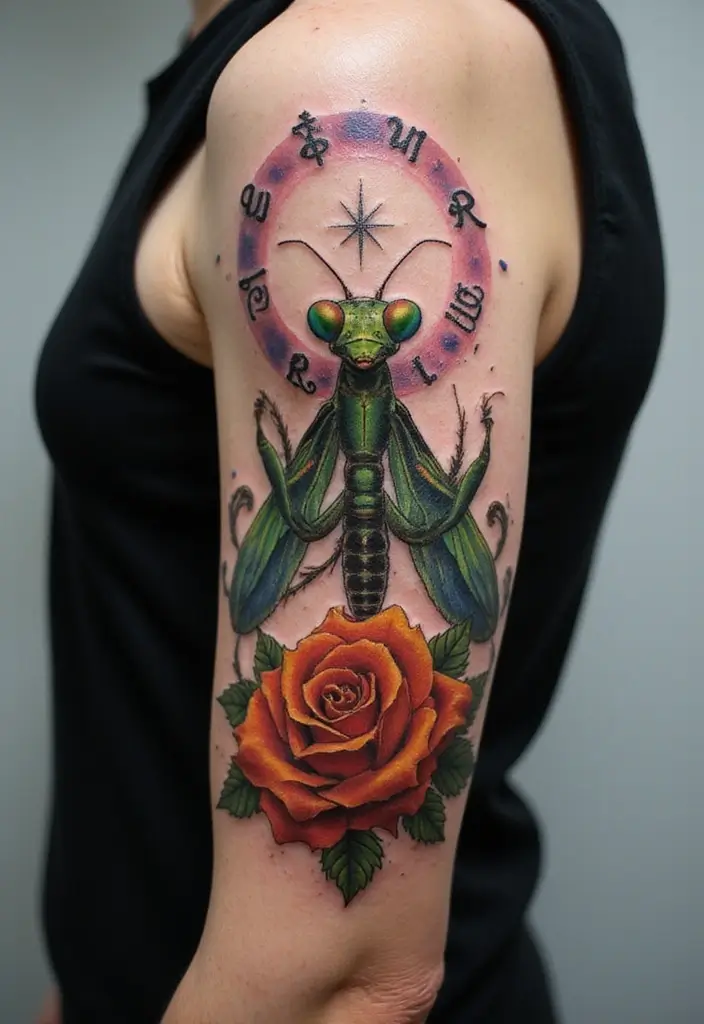
You want a tattoo that blends nature with the night sky. A praying mantis with astrology symbols gives that mix. The mantis can stand as a guide on your cosmic path. You show who you are in a personal, small art piece.
Design ideas:
– Pair the mantis with zodiac signs that match your traits.
– Let the glyphs circle the insect or sit along its wings.
– Add tiny stars or a faint constellation to hint at the heavens you follow.
– Use planets to mark big moments in your life.
– Keep the lines clean so each symbol stays clear.
Placement and style:
– This look works on the upper arm or back.
– A fine line or dot work approach keeps the design delicate.
– A touch of shading adds depth without crowding.
– White ink or metallics can make the stars shine.
What it says:
– The tattoo marks your link to the cosmos.
– It sketches your inner traits and hopes.
– The mantis acts as a quiet guardian of your chart and choices.
Practical tips:
– Start with one clear symbol and add others later if you want.
– Map the layout with light pencil lines first.
– Choose skin-safe inks and a studio that follows hygiene rules.
– Keep the design clean and simple for a timeless look.
30. Mantis and Music
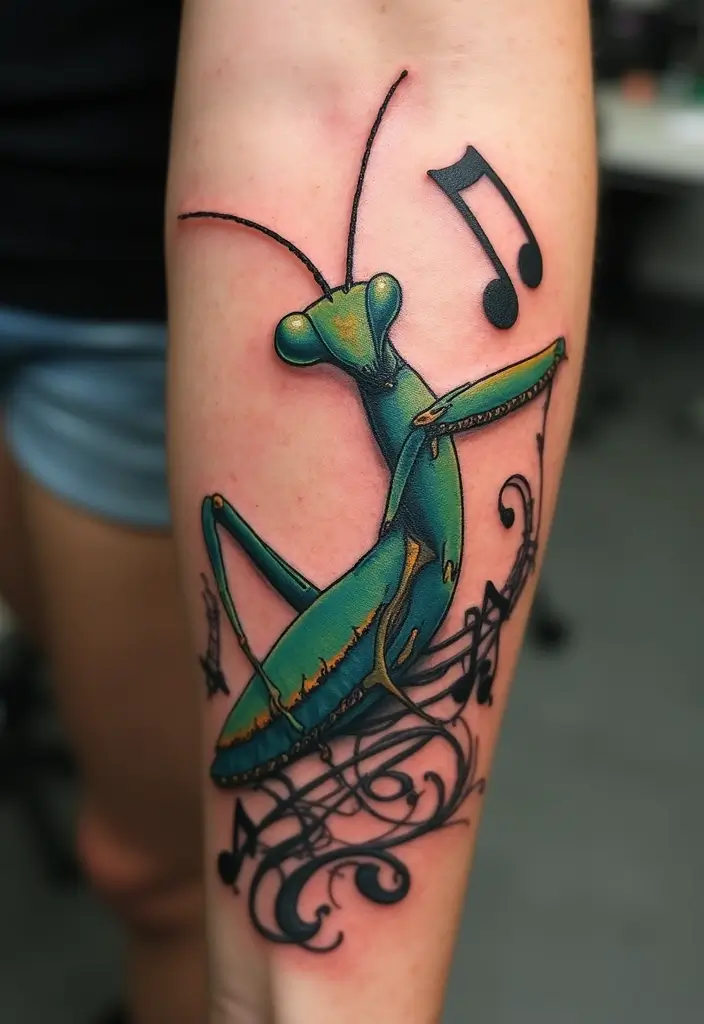
You want a tattoo that shows your love of music and a praying mantis. The mantis stands for focus and balance. Put them together, and you get a piece that moves with your days.
Design ideas:
– A mantis with music notes trailing from its antennae.
– The mantis perched on a guitar neck with tiny notes around.
– A mantis inside a frame of piano keys or drumsticks.
– Notes forming a soft halo around the insect.
– Clean line work in black with a dash of color to match.
Color and style:
Pick colors that fit your tunes. Bold tones work for upbeat songs. Soft tones fit classical vibes. If you want more texture, add subtle shading or a light wash of watercolor to keep the look fresh but clean.
Placement and scale:
The arm and forearm give room for details. The chest near the heart makes a strong personal statement. Small pieces fit nicely on the inner wrist.
Working with your artist:
Bring clear references. Note what you like about each one. Ask for a clean stencil and a light outline. Check how shading will move with your skin.
Care and maintenance:
Follow aftercare. Avoid sun in the first weeks. Use fragrance-free lotion and keep skin hydrated.
Next steps: Book a consult. Share your ideas. Look over rough sketches and pick the look that fits you.
A traditional praying mantis tattoo paired with music is more than art – it’s a reminder to stay focused and balanced through life’s melody. Let your ink tell your unique story!
Conclusion
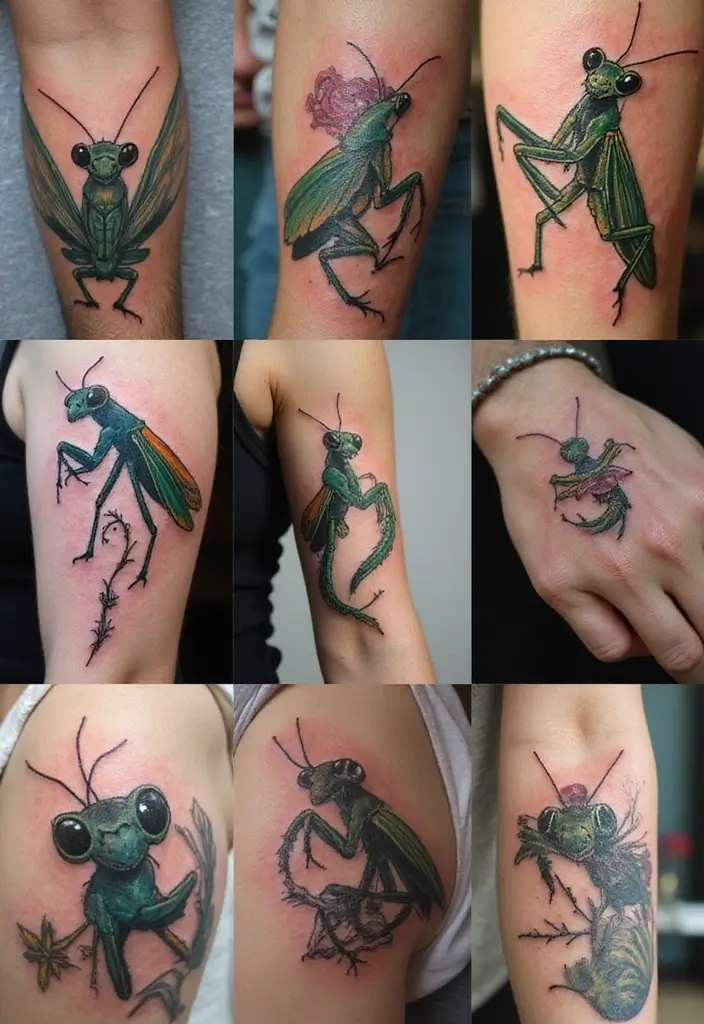
These 30 traditional praying mantis tattoo ideas celebrate the beauty, symbolism, and diversity of nature.
From classic designs to modern interpretations, each tattoo serves as a unique expression of personal meaning and creativity.
Whether you’re considering your first tattoo or adding to your collection, letting your love for nature inspire your choice can lead to a beautiful piece of art that resonates with you.
Frequently Asked Questions
What Are the Popular Styles of Traditional Praying Mantis Tattoos?
Traditional praying mantis tattoos come in various styles that cater to different tastes! You can explore designs like the Classic Green Mantis for a serene touch, or opt for a Watercolor Mantis for a vibrant, artistic flair. If you prefer something timeless, the Black and Grey Mantis is an excellent choice, using shading to ensure longevity. Don’t forget about the bold look of Tribal Mantis tattoos or the modern twist of Geometric Mantis designs!
What Does a Praying Mantis Tattoo Symbolize?
A praying mantis tattoo often symbolizes patience and focus. This fascinating insect embodies a calm approach to life, reminding wearers to act thoughtfully and deliberately. Additionally, combining the mantis with other elements, like flowers or mandalas, can further enhance its meaning, representing strength, balance, or your personal journey through life.
How Do I Choose the Right Mantis Tattoo Design for Me?
Choosing the perfect mantis tattoo design is all about personal expression! First, consider what the mantis symbolizes for you—patience, focus, or strength. Then, think about the style that resonates with you, whether it’s traditional, watercolor, or minimalist. You might want to incorporate other elements like flowers or cosmic symbols to make it unique. Lastly, consult with an experienced tattoo artist who can help bring your vision to life while ensuring it fits well with your body’s canvas!
Are Praying Mantis Tattoos Suitable for Both Men and Women?
Absolutely! Praying mantis tattoos are incredibly versatile and can be designed to appeal to anyone, regardless of gender. The beauty of these designs lies in their adaptability; you can create a bold tribal mantis for a striking masculine look or opt for a delicate mantis with flowers for a softer, feminine touch. Ultimately, it’s all about what speaks to you and reflects your personality!
How Can I Care for My Praying Mantis Tattoo After Getting It?
Caring for your new praying mantis tattoo is essential for its longevity and vibrancy! After getting inked, follow your tattoo artist’s specific aftercare instructions, which often include keeping the area clean and moisturized. Avoid direct sunlight and soaking in water for a few weeks. You might also want to apply a gentle, fragrance-free lotion to keep your tattoo hydrated. Proper care ensures your tattoo remains a stunning piece of insect tattoo art for years to come!

